50th Anniversary reminiscences by Derek Butcher for Darwin Conference.
DD1105c Golden Oldies
by Derek Butcher, May 2011
I suppose it could be said that I burst into the Bromeliad scene in the 1970’s and even at that stage I was asking questions!
Can you remember back to your school days when teachers were always old? I know that my schooldays were during World War II where the young teachers were out fighting somewhere but this phenomenon is still with us. If you ask a grandchild how old their teacher is you will invariably hear one word “Old” So I could have entitled my talk “Golden Teachers” but that doesn’t sound as good. Or “When we were Young’ or even “Salad Days”.
I can only reminisce about people who got asked questions and bothered to answer me. So they may not coincide with what you envisage as “Golden Oldies”.

I will only cover Aussies in this presentation and will start with my home State and move around the Country in a clockwise direction.
The only person in Adelaide who was really keen on Bromeliads was Ede Schaefer who regrettably passed away in 1985 while at the peak of his interest. Where ever you saw Bromeliads on display at any Show you would find Ede and his wife Freda somewhere about. He was the prime mover of a Bromeliad Study Group in 1976 and the formation of the Bromeliad Society of S A in 1977. You learnt enthusiasm from Ede. He was busy propagating from seed and importing plants from Germany while I was busy learning names and what they meant.
In the early 1980’s he sent plant lists around Australia. The prices were very reasonable at about $2 - $3 but there were these ones marked ASK. Here you contacted Ede as fast as you could because even though you knew the price would be high there was a slight chance that the last one had not just been sold. This was the time that Ede was importing, mainly from Germany and when Quarantine restrictions said “ONLY 6 PLANTS PER SPECIES”! It was odd how many different names there were for similar looking plants! I was even asked to confirm Ede’s thoughts on the similarity of plants before he submitted the order (Hush Hush) so that the person in Germany knew what ones had to have different names. I am sure that it was because of Ede’s efforts that the “6” requirement was dropped as being unworkable!
Ede died in 1985 and despite all his efforts no plants were named in his memory. Only recently, in 1998, Freda showed me an unknown variegated Nidularium from the ‘Old Days’ and I decided to call it Nidularium ‘Elfriede’ in her honour.
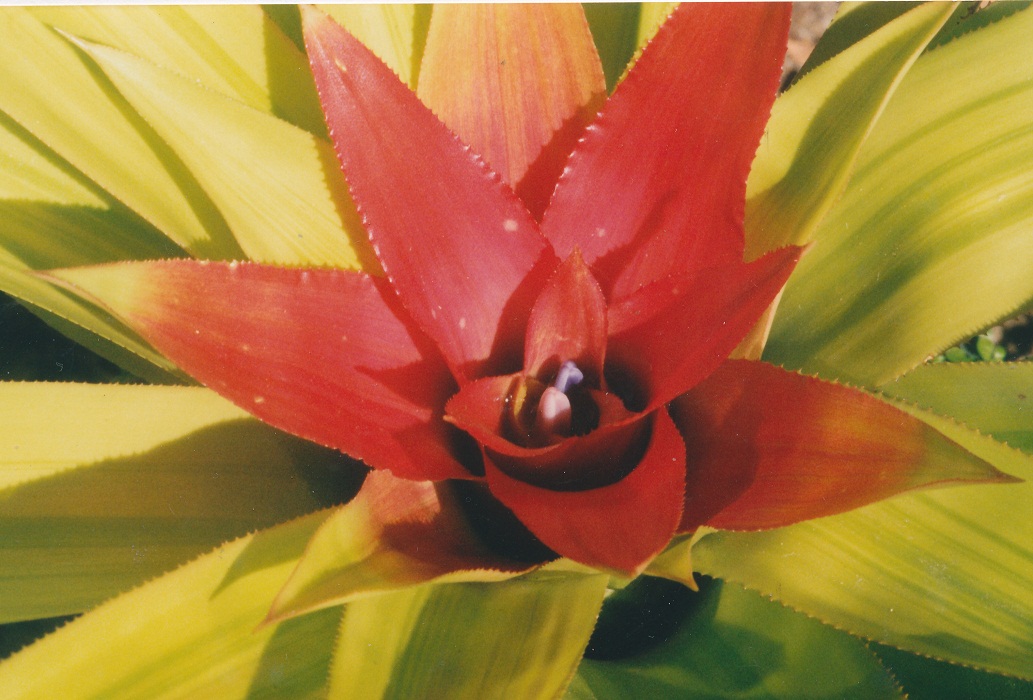
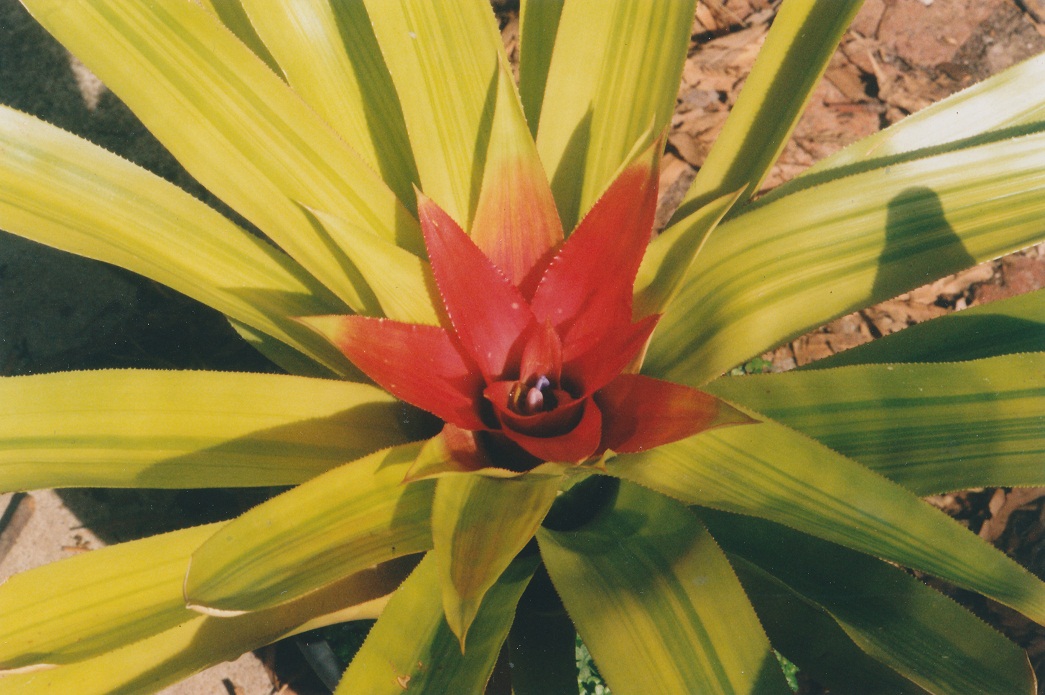
Now to Western Australia to a place some 200 kms south of Perth called Margaret River. Here hidden amongst the forest you could find Bernard Stonor. Bernard was better known for being a prodigious correspondent and wrote many thought-provoking articles for Bromeletter and the Journal of the Bromeliad Society in America. Not many Bromeliad growers met him in habitat! The name Bernard Stonor always conjures up to me a chap in shorts and Wellington boots in wintry August AND a great smile of welcome. While his writings were serious stuff about personal observations and wrongly named plants he had a quirky sense of humour. For example, he won a prize at the Margaret River Horticultural spring Show for a flower in container by exhibiting a daffodil in a Billbergia tube.
He did a few hybrids at a time when grex ruled. We had Billbergia ‘Red Surprise’ which he had obtained by crossing ‘Bobtail’ with nutans. What is interesting is that ‘Bobtail’ originally came to us as ‘Henry Teuscher’ but clearly the tags got transposed in an import batch. (Let’s blame the Quarantine people – Again!). Bill Morris still believes ‘Bobtail’ is a species because it breeds true to type but neither he nor I can agree as to which species it is! Conversely, Bernard had doubts on the species status of his nutans! Anyway, when we got a plant of Billbergia ‘Red Surprise’ in Adelaide we were muchly pleased. Some years later, after Bernard’s death, Geoff Lawn advised he had at least 4 different sorts of ‘Red Surprise’ which was yet another surprise to me. The variation was not in the inflorescence but in the plant shape.


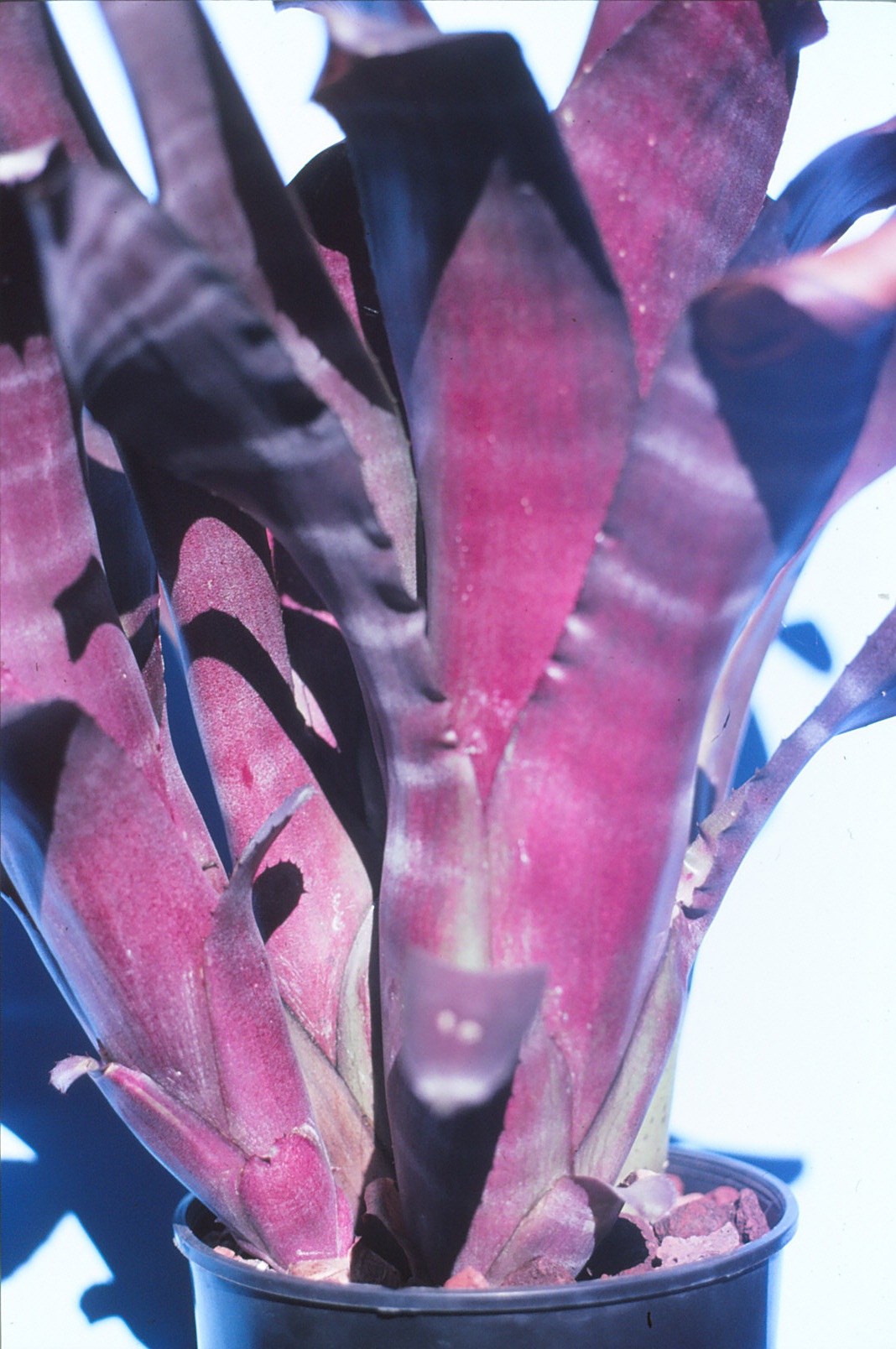
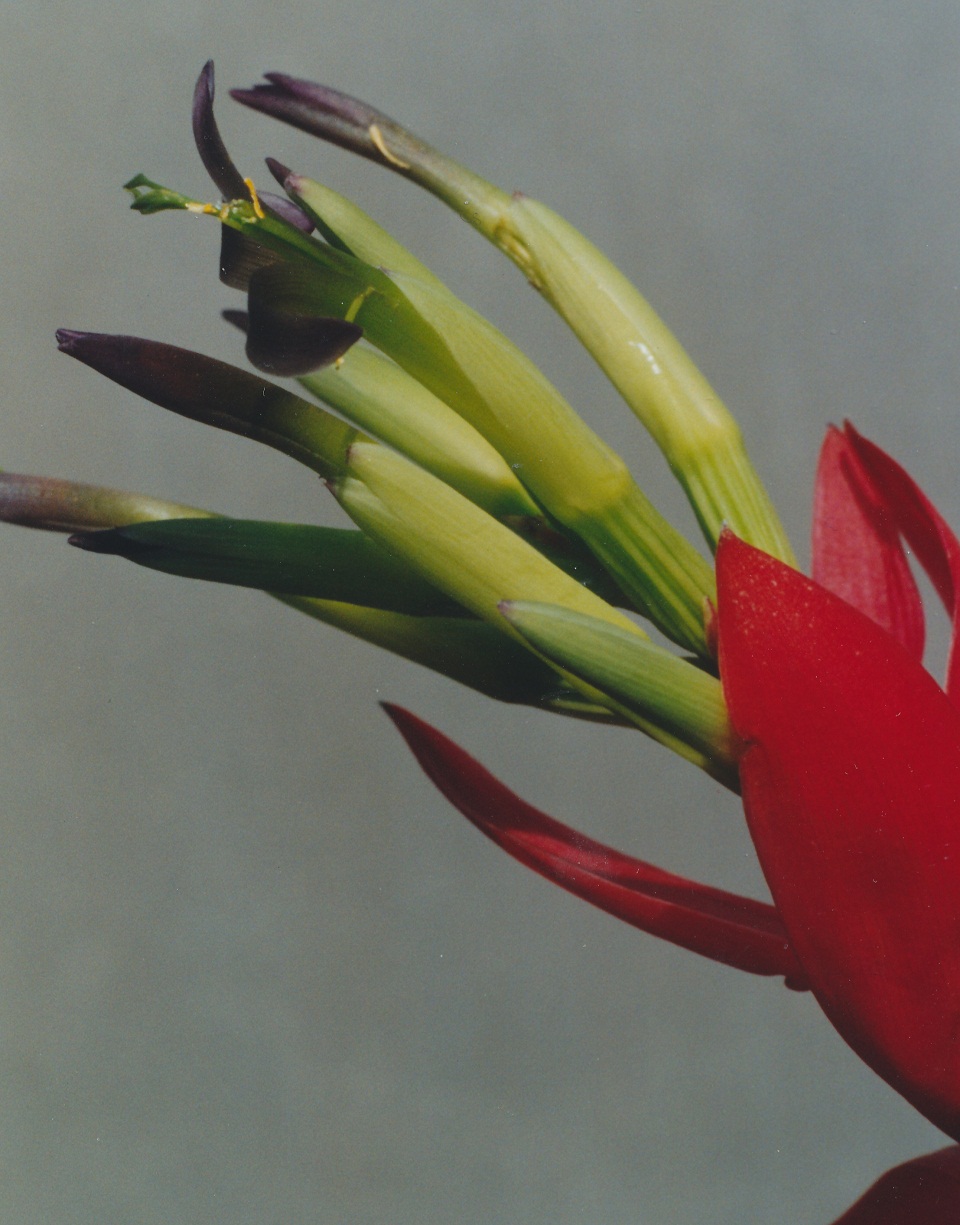
| Billbergia ‘Red Surprise’ | Billbergia ‘Margaret River Red’ |
Another of Bernard’s hybrids was Billbergia ‘Springtime’ where he had sent us two plants just before his death. One had green petals with blue edges and a more impressive one with totally blue petals. In honour of Bernard we decided to call the totally blue petalled one ‘Bernard Stonor’.
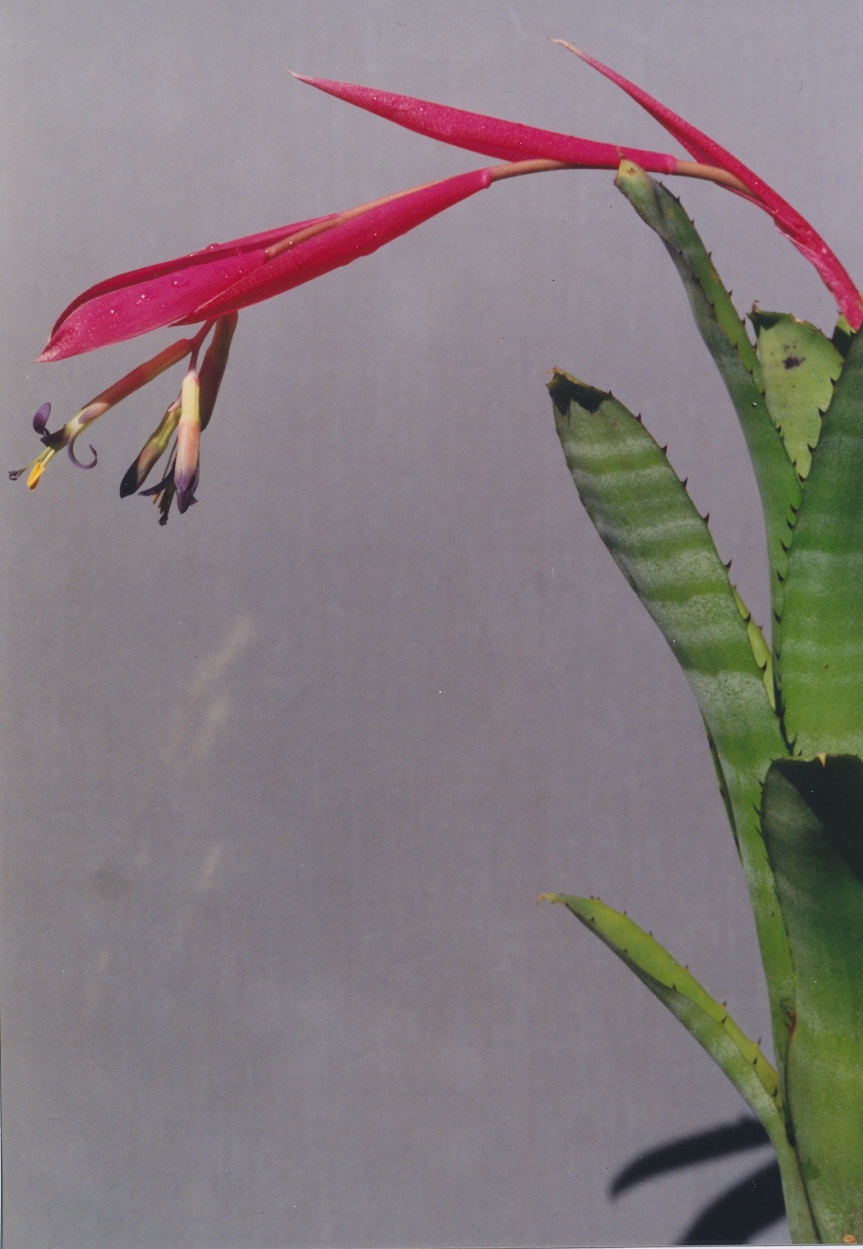
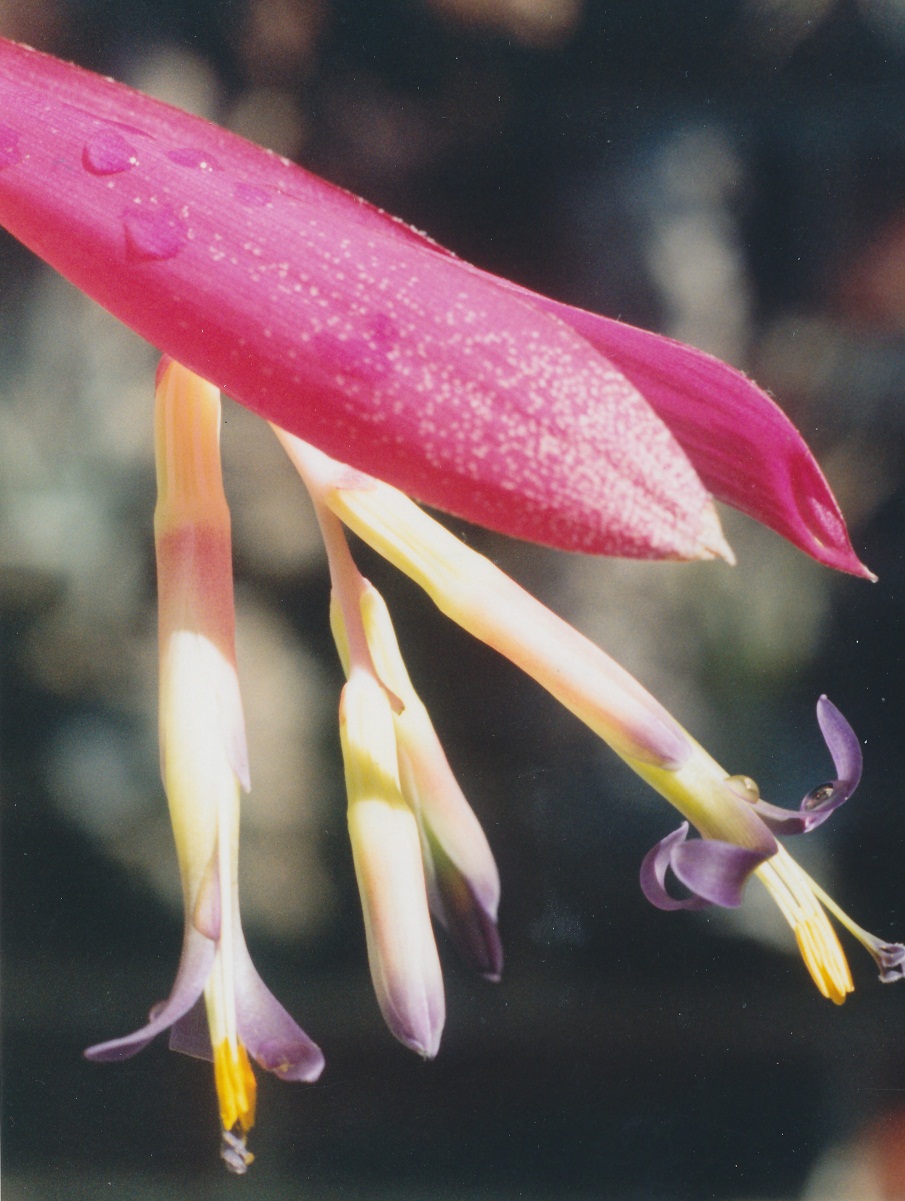
| Billbergia ‘Bernard Stonor’ |
And so to Queensland where 3 stood out in the influence they had on me. They were Olwen Ferris, Grace Goode, and Len Butt.
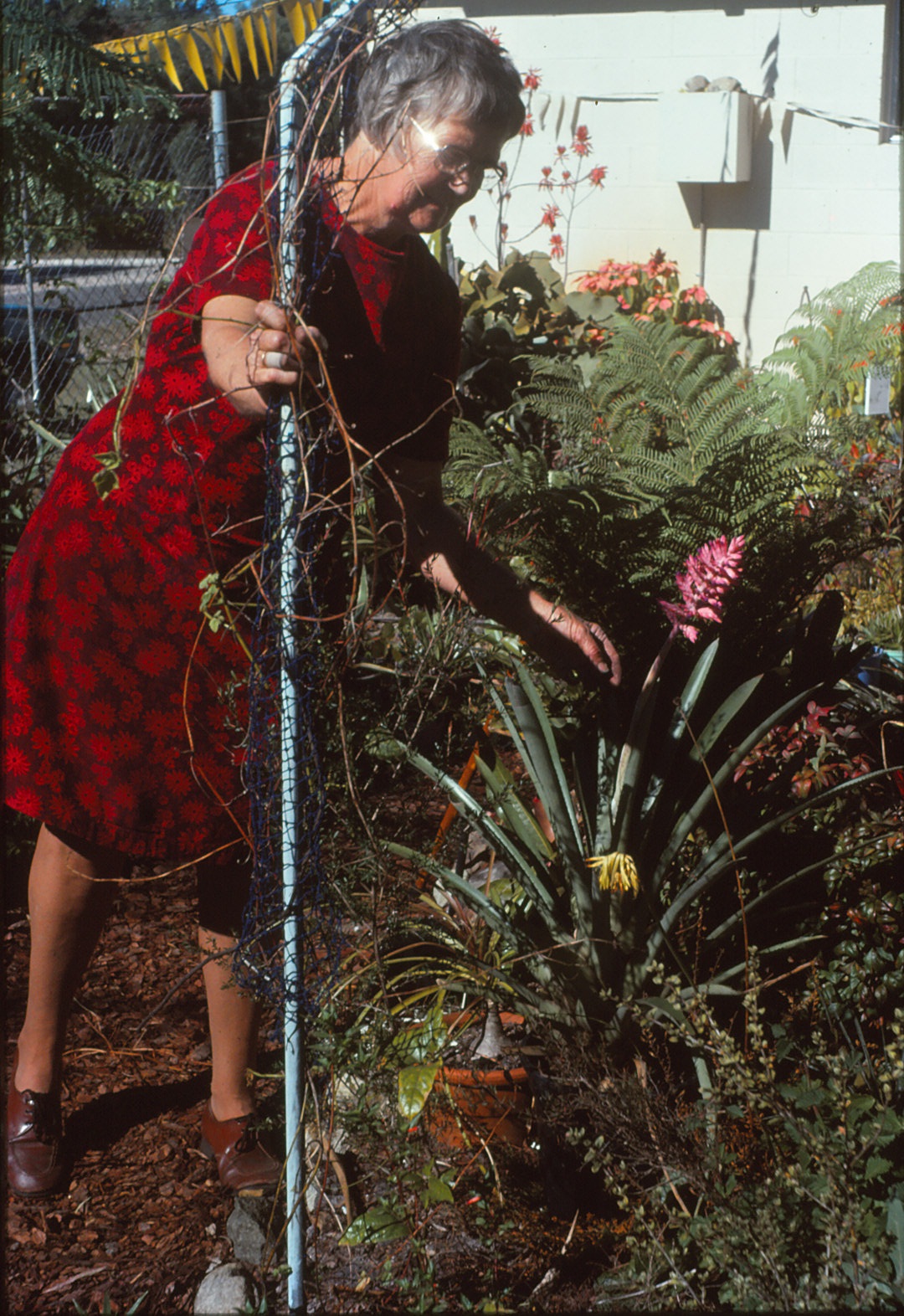
| Olwen Ferris 1980s. Aechmea distichantha? |
I mention Olwen Ferris because if you were after a plant she probably had it SOMEWHERE. At that time I had never seen a collection so varied and so jam-packed full of excitement. One thing I did learn was that you always carried a large pair of scissors with you in a Queensland garden. Every so often Olwen would turn away from you making you wonder whether you had halitosis but a quick peek showed she was using her scissors to good effect. Etiquette had it that visitors were never shown two halves of a grasshopper!
I always found her Catalogues fascinating and to this day I have one or two on file even though 30 odd years have passed. Admittedly they now have a different fascination because I find them of help in trying to trace what an old hybrid looked like. Remember in those days colour photography was not high quality. Just one example is Billbergia ‘Violet Beauty’ which I am sure is of US origin but they just confuse it with Billbergia pyramidalis including Mr Billbergia himself, Don Beadle.
I still do not know if my getting him into a corner in this regard made him leave Bromeliads and go and live on a boat!
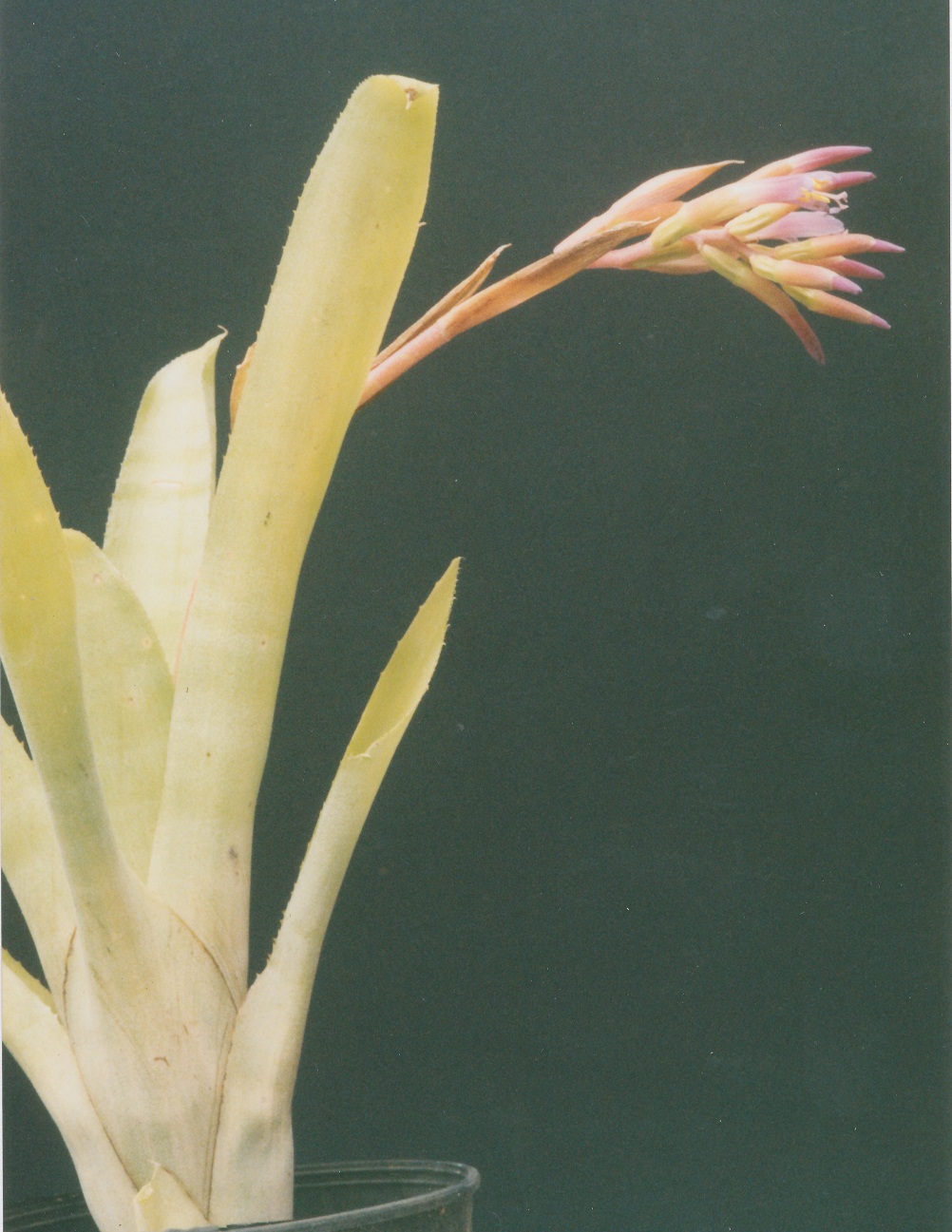
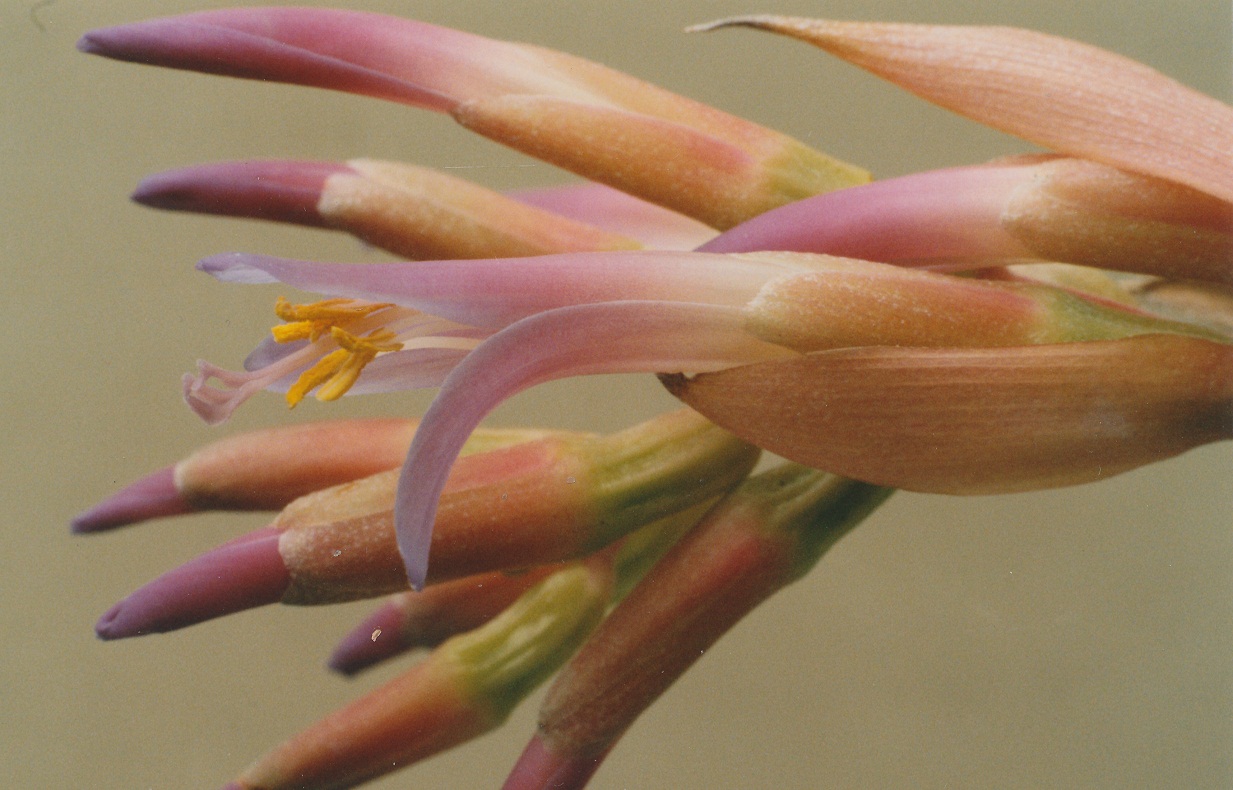
| Billbergia ‘Violet Beauty’ |
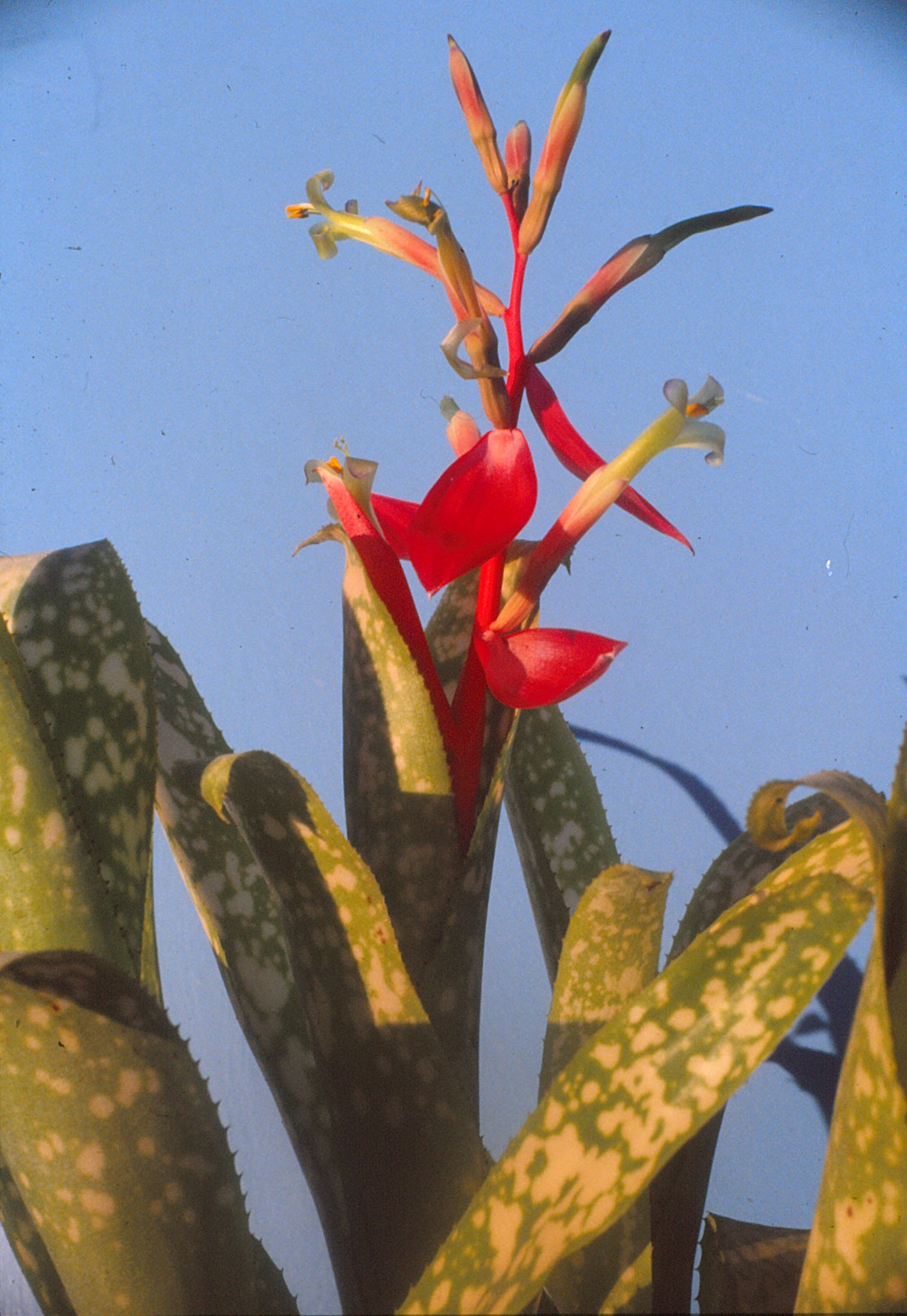
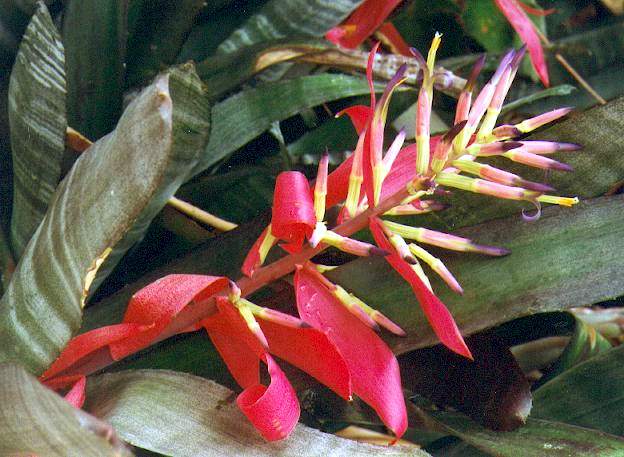

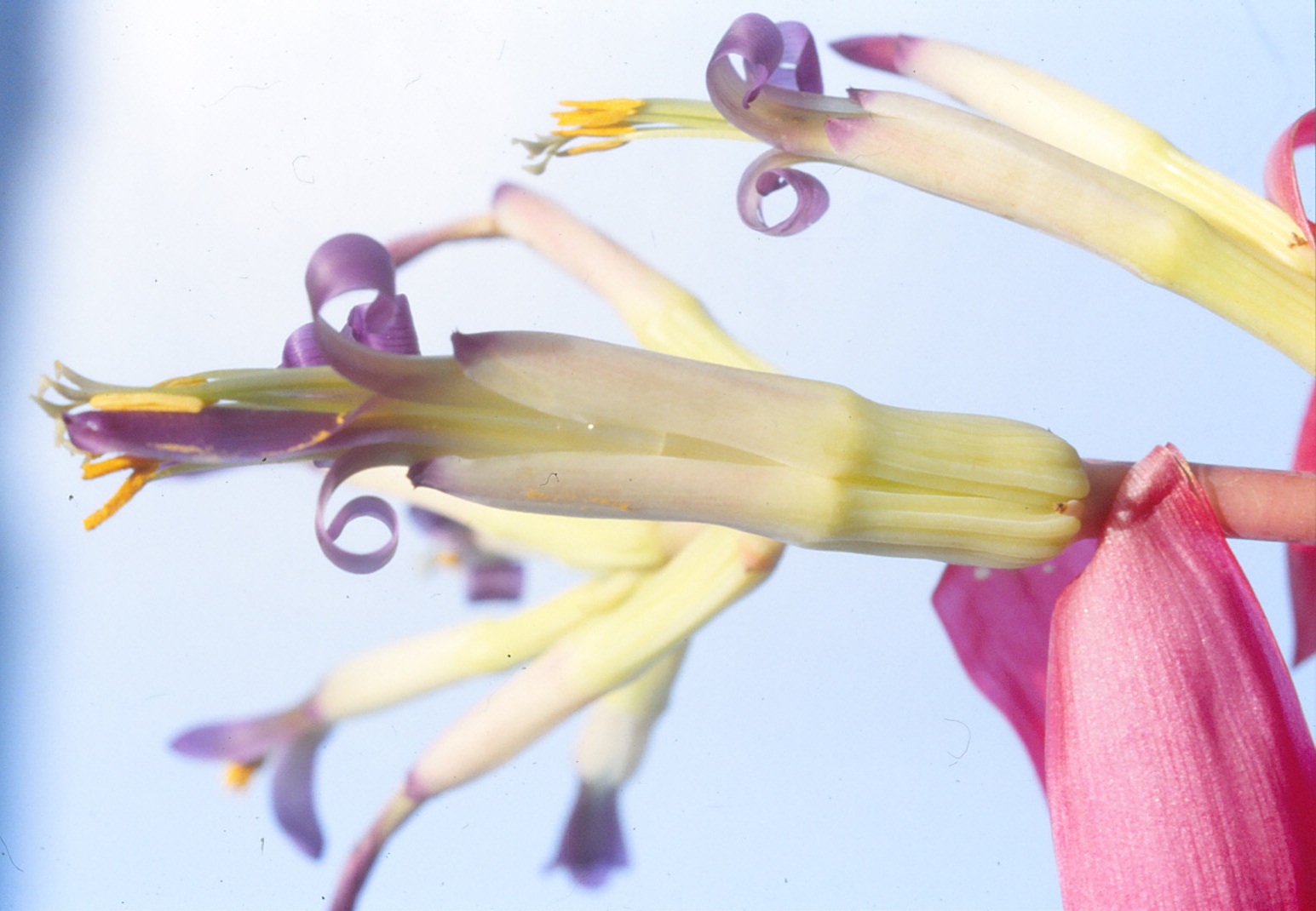
| B. ‘Storm’ | B. ‘Chas Webb’ which Olwen named |
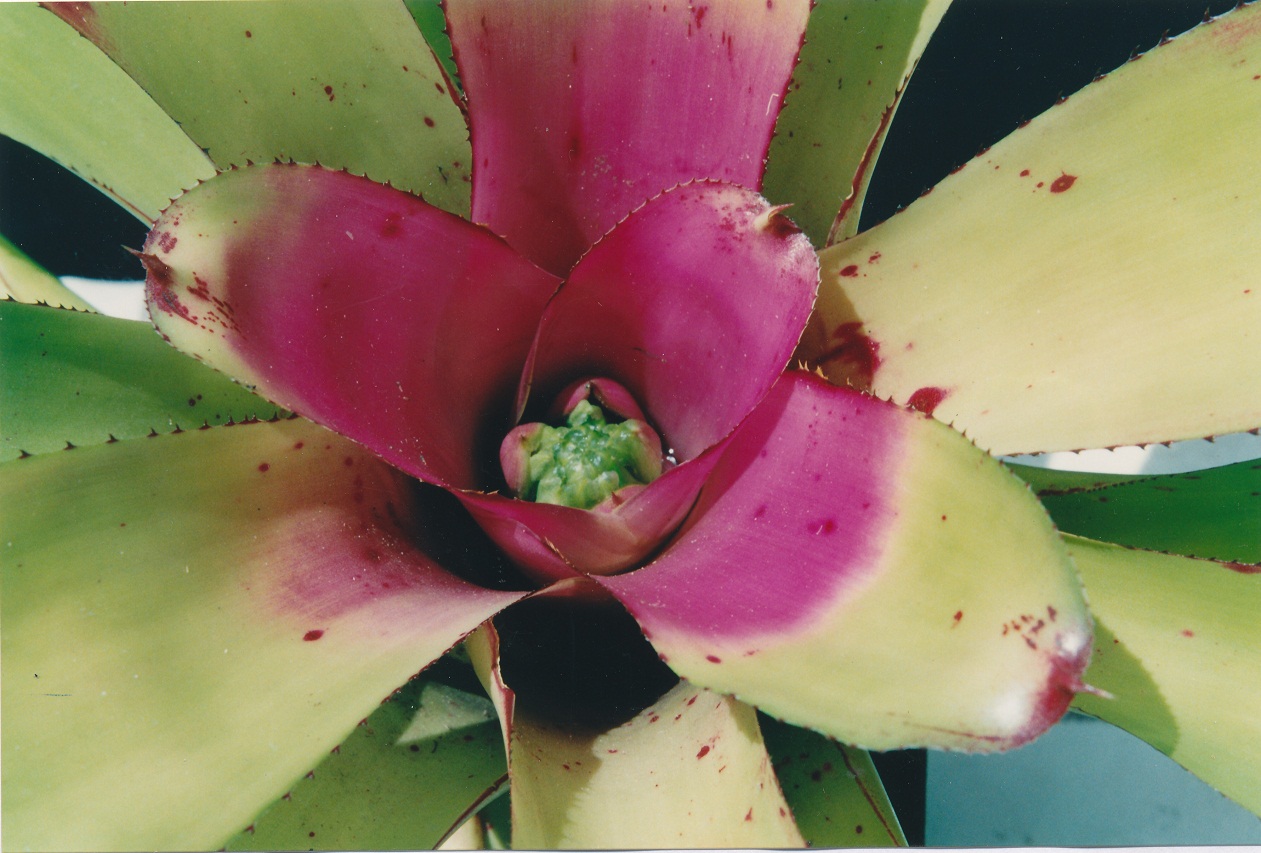
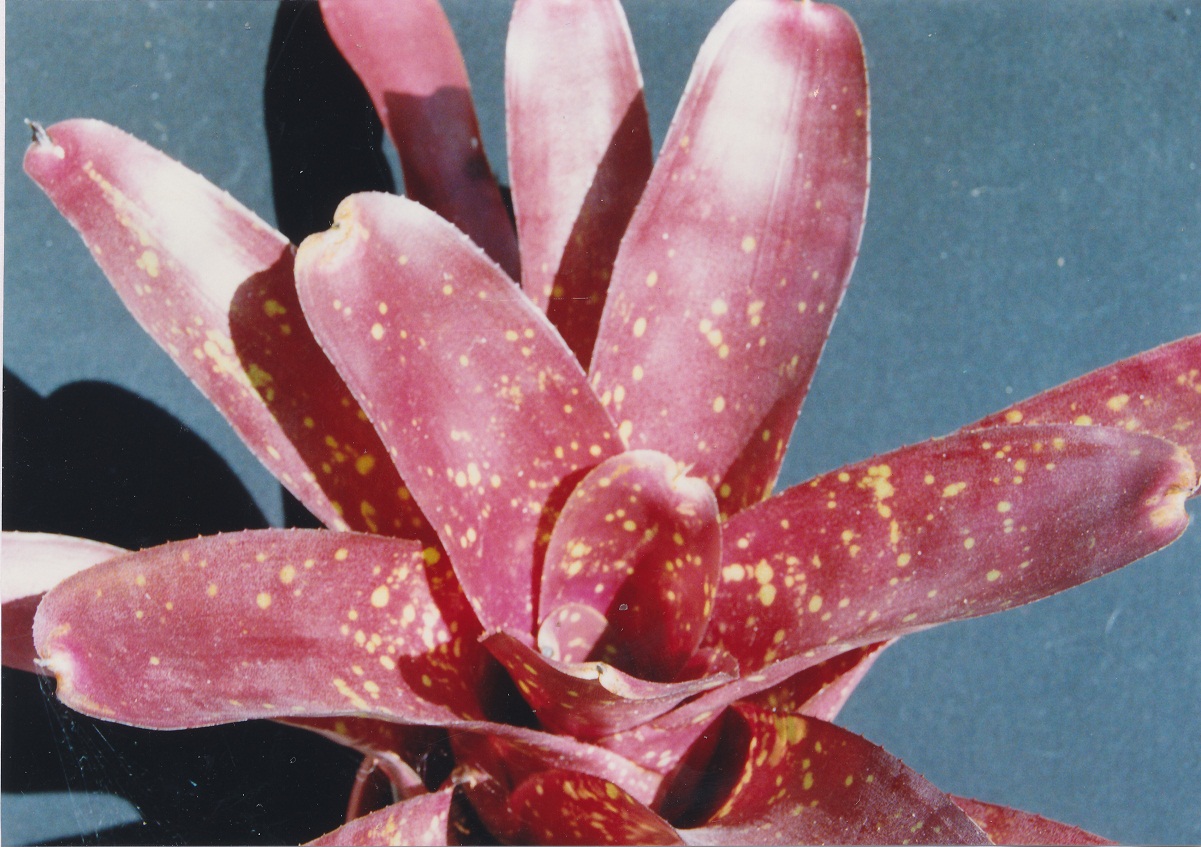
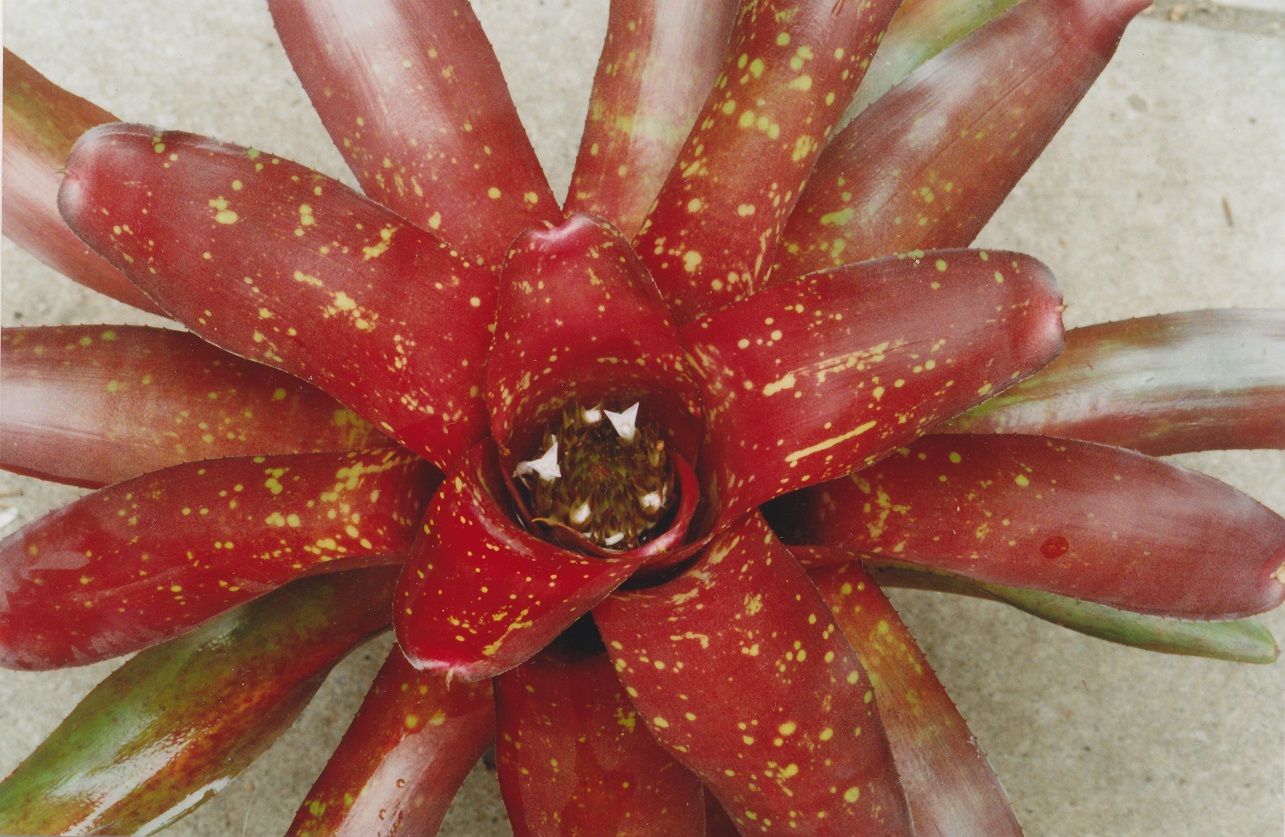
| N. ‘Olwen Ferris’ a hybrid by Olwen but named by Grace | N. ‘Beefsteak’ |
Olwen was not a prolific hybridist although she did grow much seed from Dr Oeser and perhaps the most famous is Neoregelia ‘Beefsteak’ which had a few brothers and sisters. Olwen was very helpful to me when I started compiling the Hybrid Check list but she was a bit reticent to cull seedlings. I remember one which was supposedly an F1 hybrid between Neoregelia carolinae and chlorosticta by Dr Oeser but Olwen has picked out some 54 DIFFERENT plants collectively called ‘Dark Delight’. We eventually whittled this down to 20 cultivar names. It was a struggle but showed Olwen’s keenness in growing all manner of types and always seeing beauty in Bromeliads.
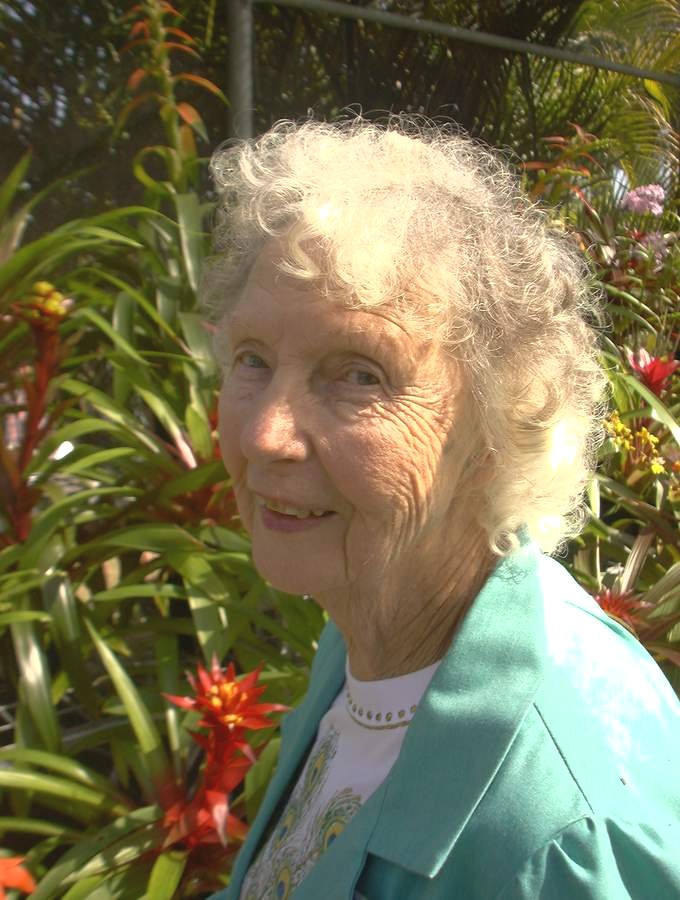
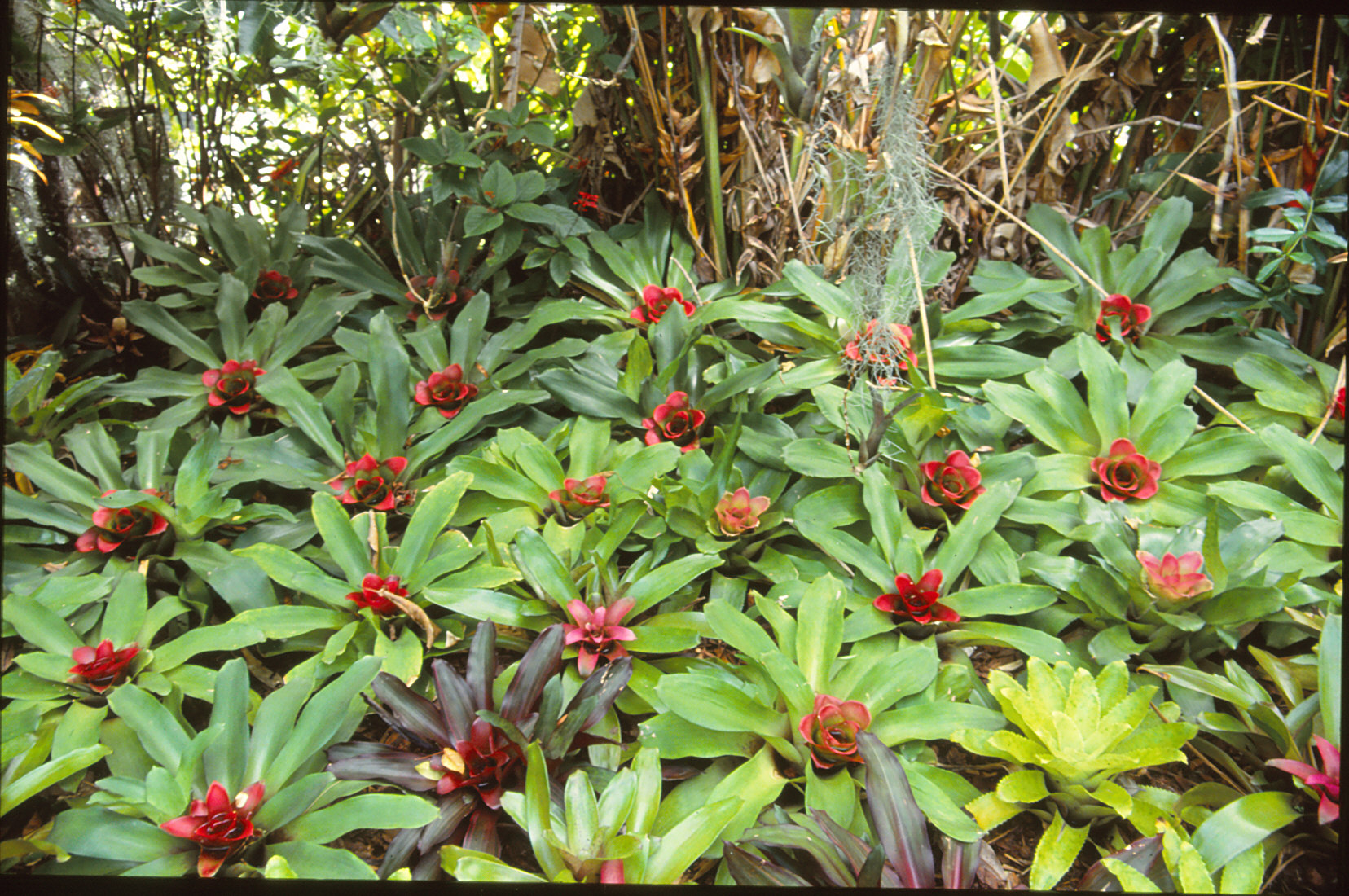
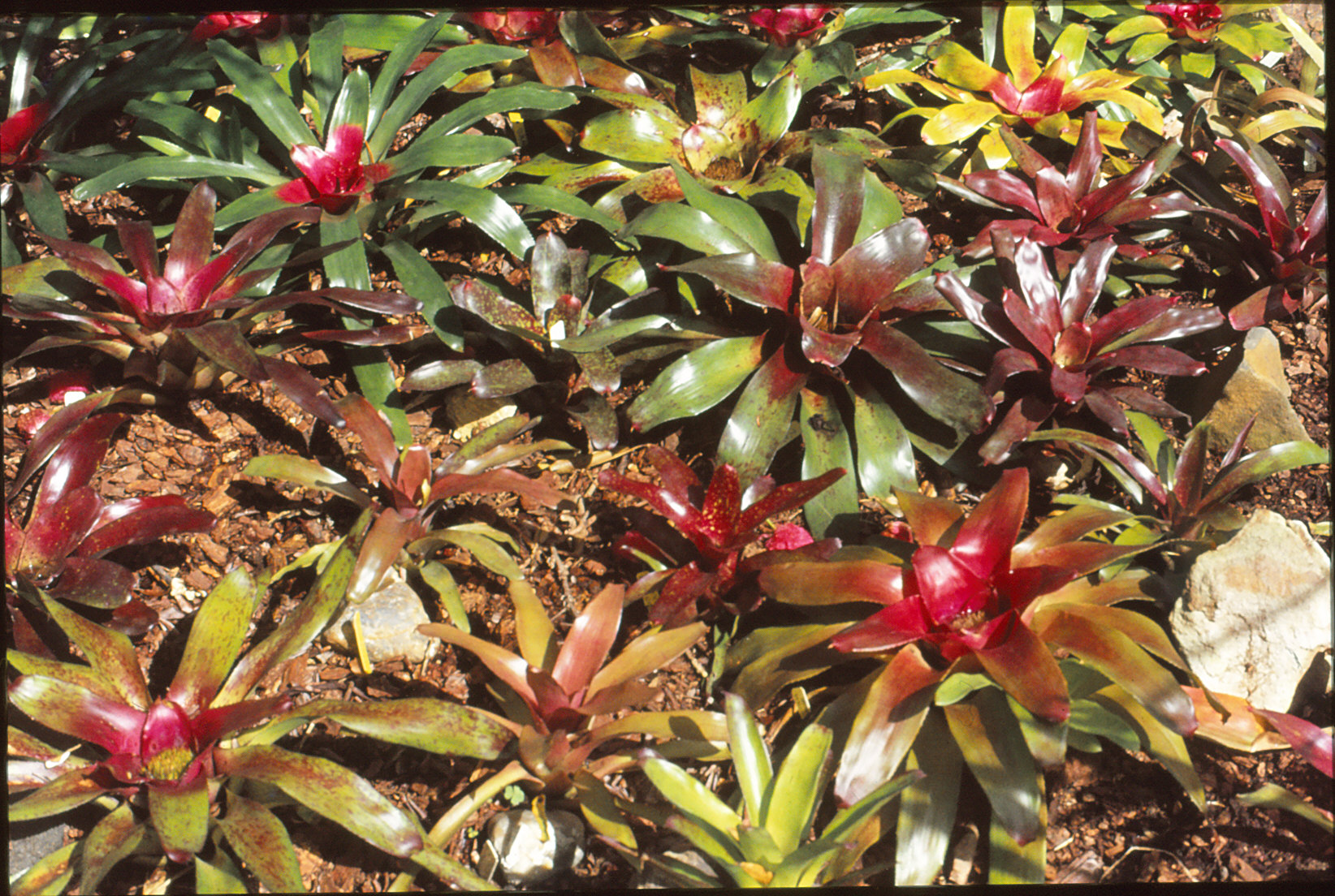

| Grace Goode OBE | Grace Goode's Garden |
Grace Goode was another because whenever I asked her a query about her hybrids she would say “I’ll check my stud book.”. I always wondered but never asked whether she kept a diary when she was a school-girl and whether it had the same title.”My stud Book”.
I suppose that 1970 was a vintage year. This was when Grace started looking at billbergias and thinking they could be improved upon. Their sex parts were clearly visible to make things easier for her!
Then it was on for good and old, with Aechmea, Neoregelia, Cryptanthus and Nidularium and a few bigenerics thrown in. In fact, as Grace herself confessed 20 years ago it was a love affair!
There is something else she confessed to 20 years ago and that was her philosophy on hybridizing. At that time there were many species to experiment with that had not been experimented with before. Grace knew that if you picked the right parents you were assured of good healthy, vigorous hybrids. At the 1981 Melbourne Conference she said she held no brief for F2 generation seedlings and pointed out that of these sorts of seedlings only 5% or so were worth growing on. In other words vigorous culling was necessary, or Quality before Quantity. As most of us know, Grace has made many truly beautiful hybrids and these are still cherished and sought after, even by the Americans.
When she did sit down she enjoyed making rugs of her own design and sometimes enjoyed that well known Scottish beverage. She has even been interviewed by Don Burke although whether this was a great experience or not only Grace can say! It may even be interwoven with some of her risque jokes. In my preparation for this talk Grace did send me some of her reminiscences and I would like to relate one or two. None can be considered as risque.
Apparently a Frank Young was a rather eccentric but lovable Bromeliad grower whose home was high up on a rocky escarpment in Sydney overlooking the sea. Two shadehouses were at the top of some very steep steps. Grace said “ One of our most prestigious growers, who has a phobia for heights, just had to get up those stairs to see those Bromeliads. Going up was alright but coming down she froze. Frank surveyed her rather ample proportions and decided his thin build was not up to the task of carrying her down. “Bring up the Whisky” he shouted to his wife. He plied our trepid climber with a couple of scotches and hanging on to Frank she was able to make it down to house level.
Frank had limited space and would throw “old Mothers” on to a pile by the side of his house. On Garden Visit days he would derive infinite pleasure out of seeing grown-up Bromeliad women going through this pile of discards saying “Just like a lot of old Chooks scratching!”
Grace also mentioned Bob Okasaki who attended the Brisbane Conference in 1985. He certainly cut a swathe through the girls. He would sit at the door of his room, playing the Japanese guitar, the samisen, and invite any Aussie female who happened to pass by to come in and listen to him play. Grace reports that none accepted his offer. It would appear that Bob was not only a failed Kamikaze pilot but he missed out on other things too!
This was the first Conference that Harry Luther attended. I told Harry that he was like Ned Kelly in being so game in correcting all our names but he was not like Bob who I associated with the hairy nosed wombat. All Australians knew that this animal eats roots and leaves or is it eats, roots, and leaves. Grace tells me that she met Bob again in Hawaii. He is now 90 and still a rascal!
What else did I learn from Grace? I think it was in trying to see the good traits in plants that could flow on into their progeny and a great gift with words in the naming of her hybrids. Oft is the time when I come across a Cultivar Name and I just know it has been coined by Grace.
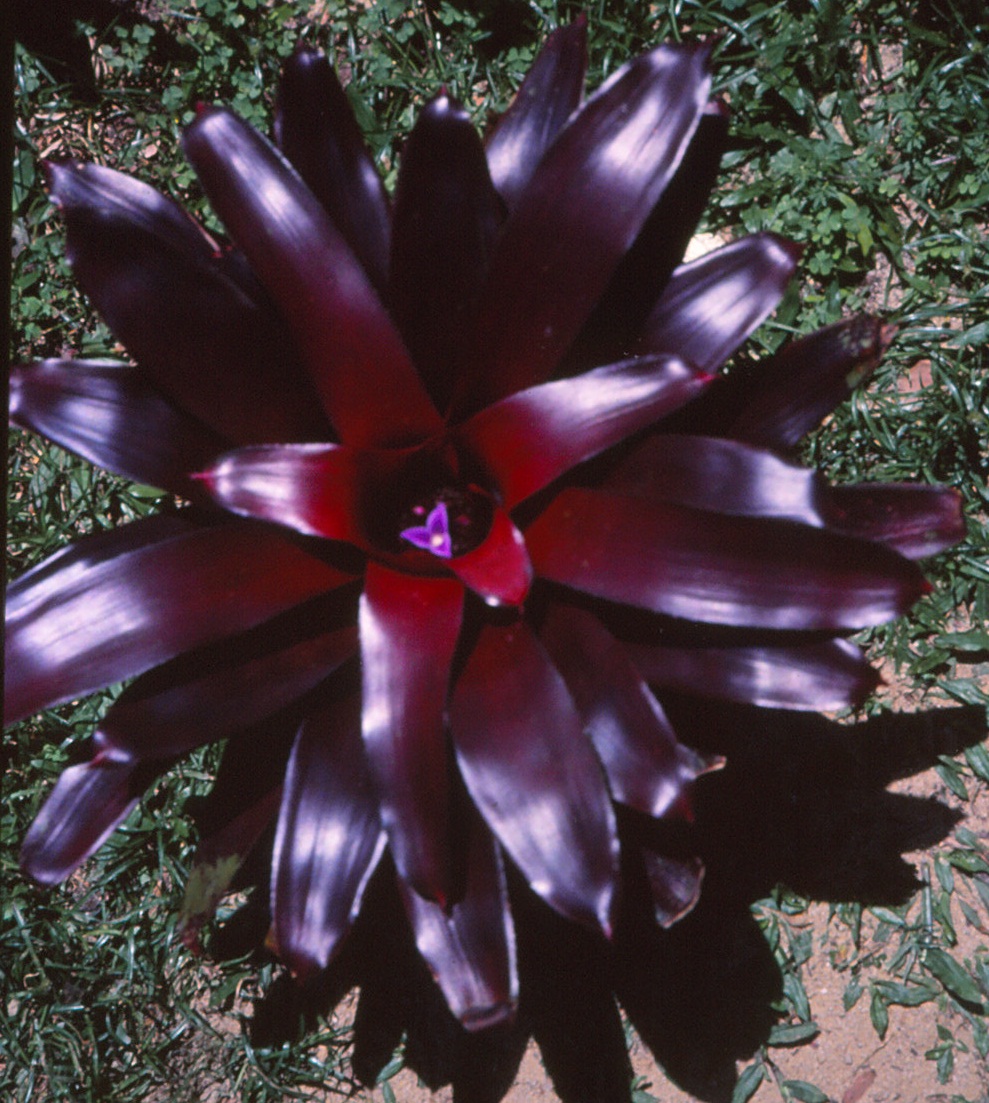
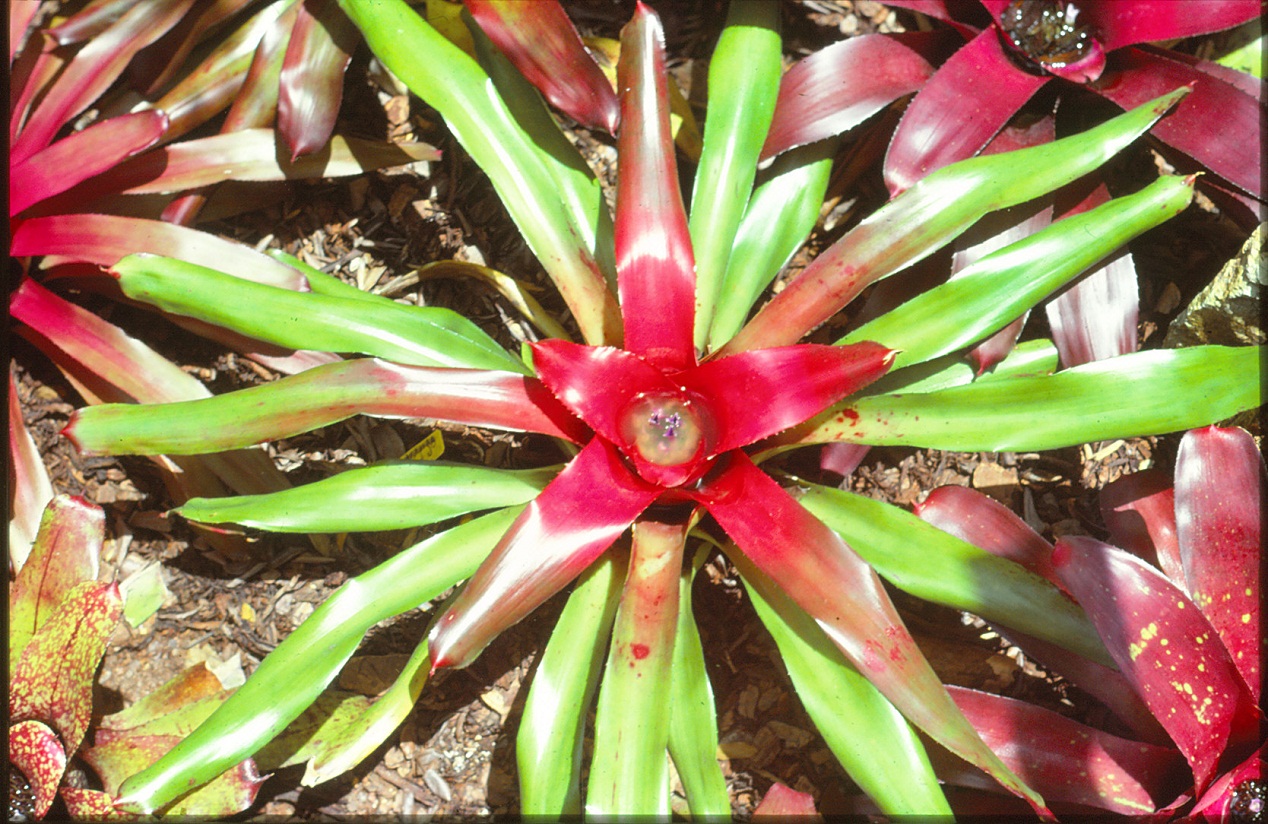

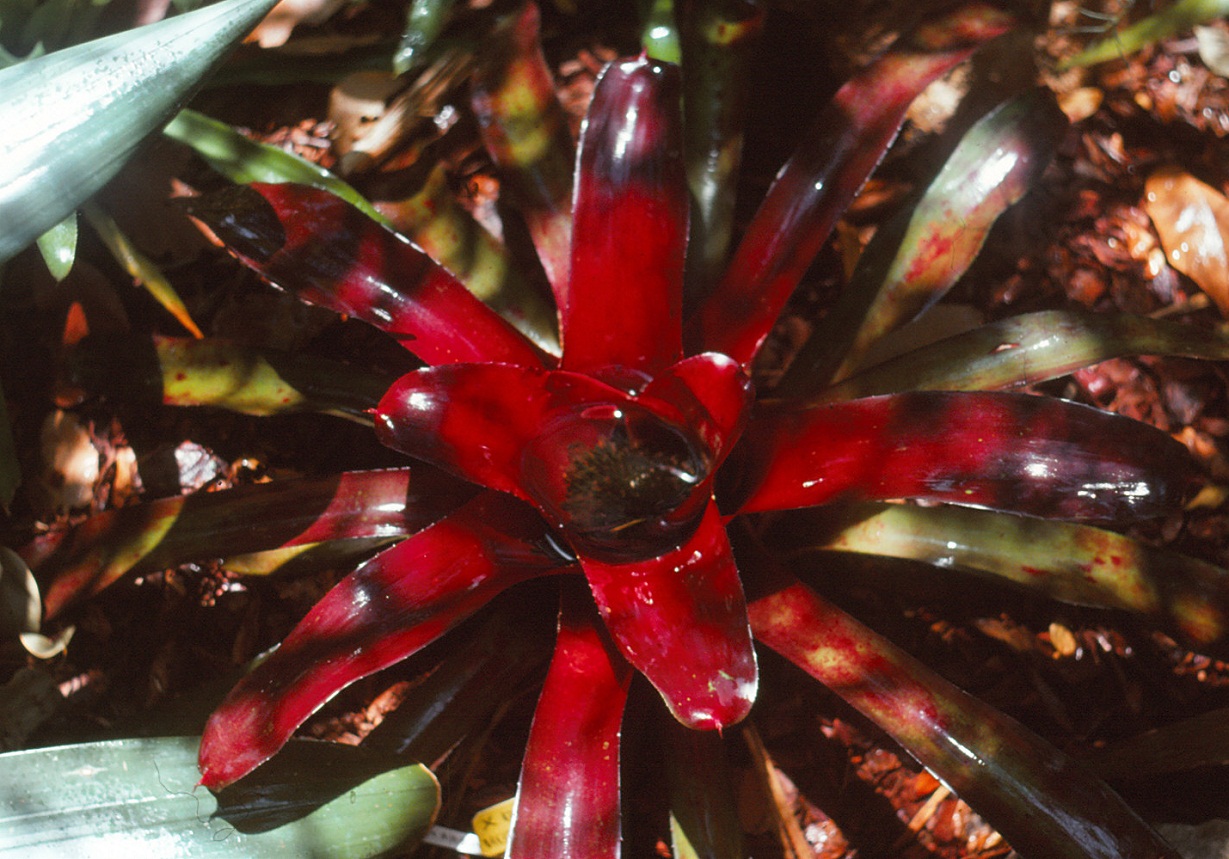
| N. 'Blackie' | N. 'Brilliance' | N. 'Charm' | N. 'Claret' |
*N. ‘Charm’ also in Padilla’s book "Colorful Bromeliads", also beware of false ‘Charms”
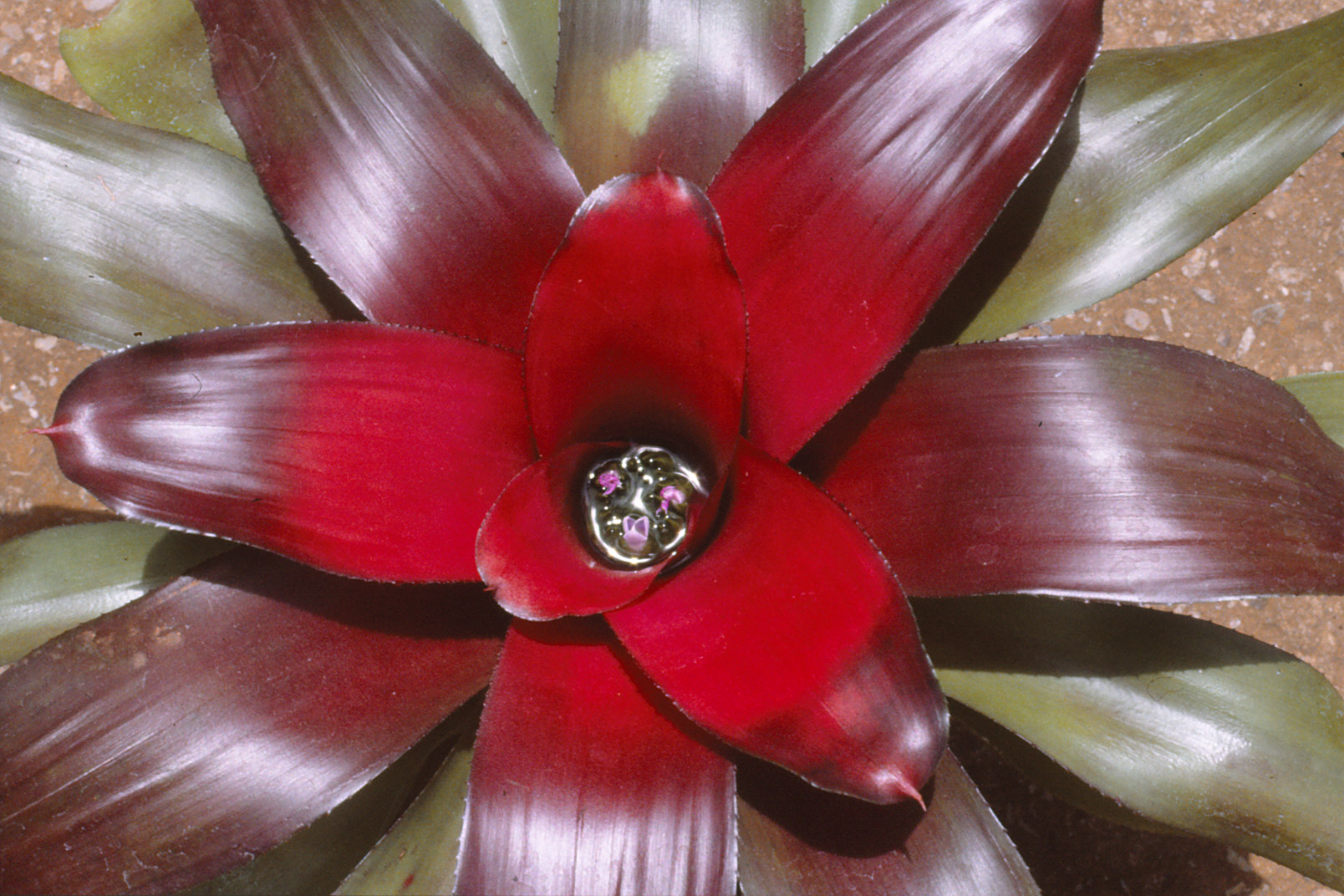
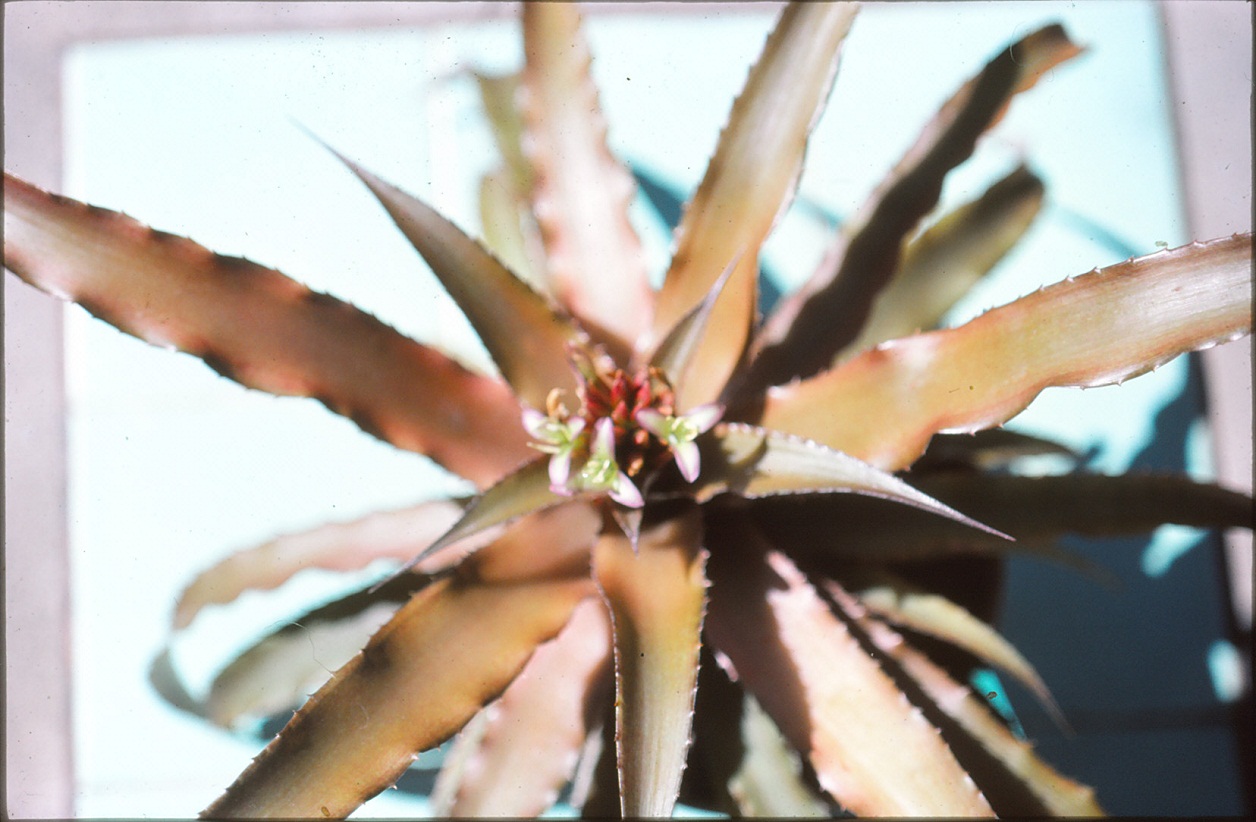

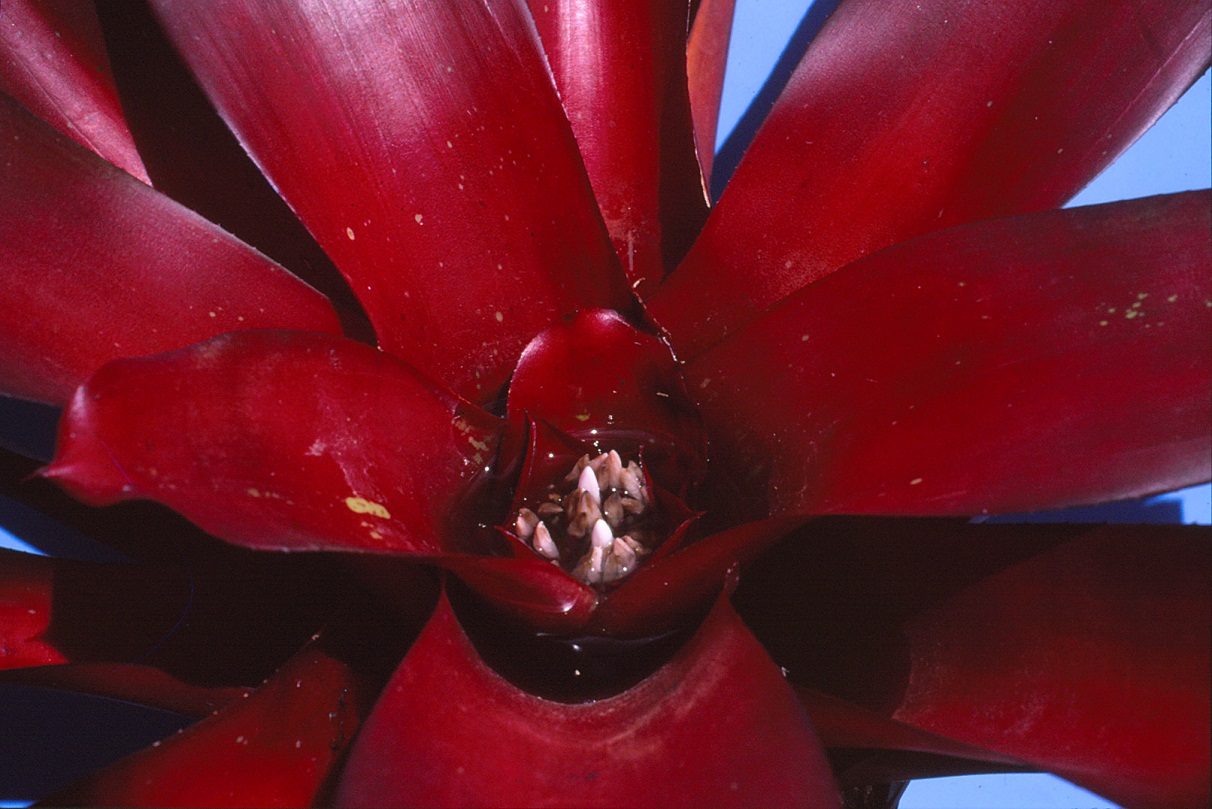
| N. 'Sheer Joy' (Colgan) | xCryptbergia 'Goodale' | xNiduregelia 'Vision Splendid' (Colgan) |
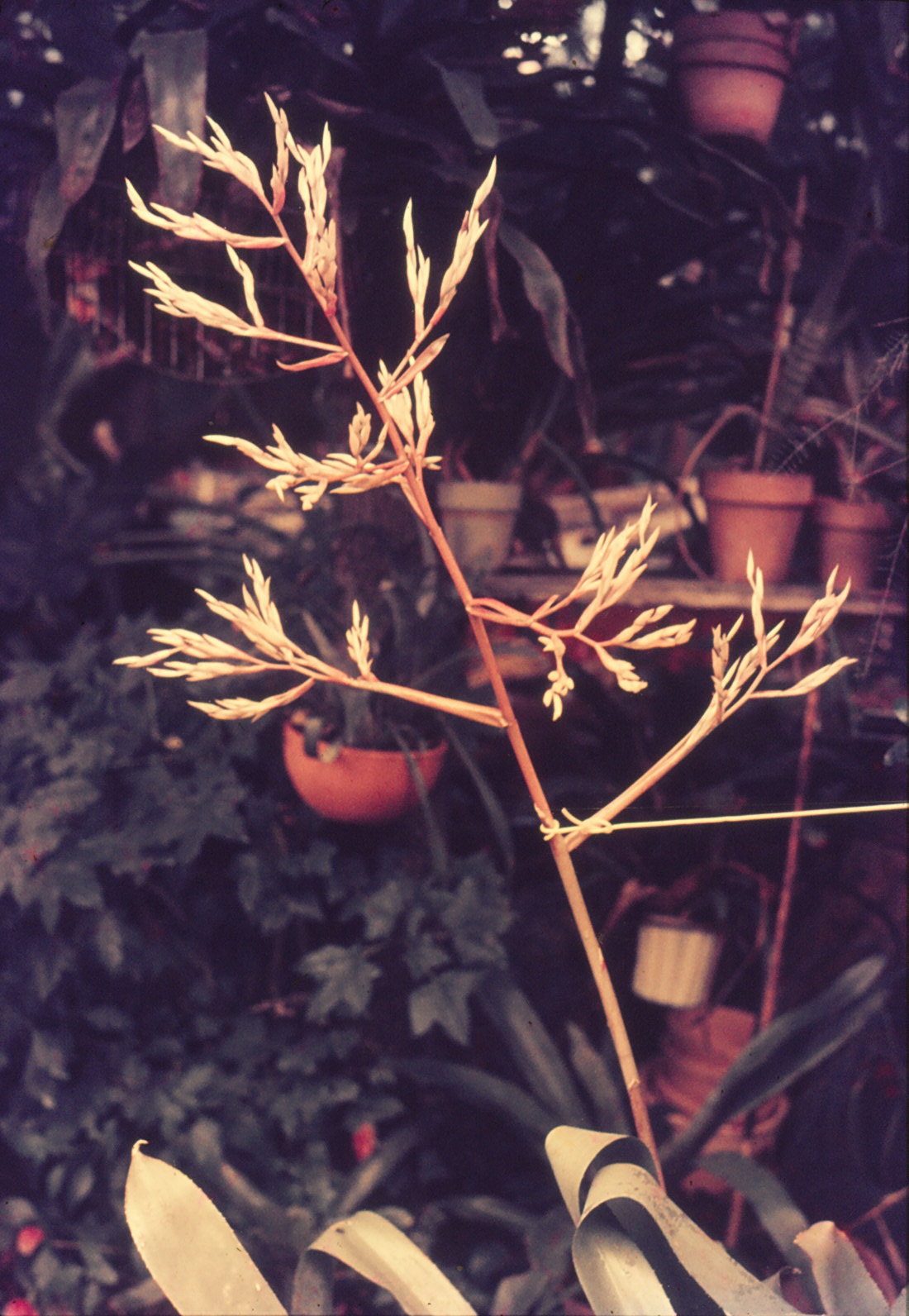
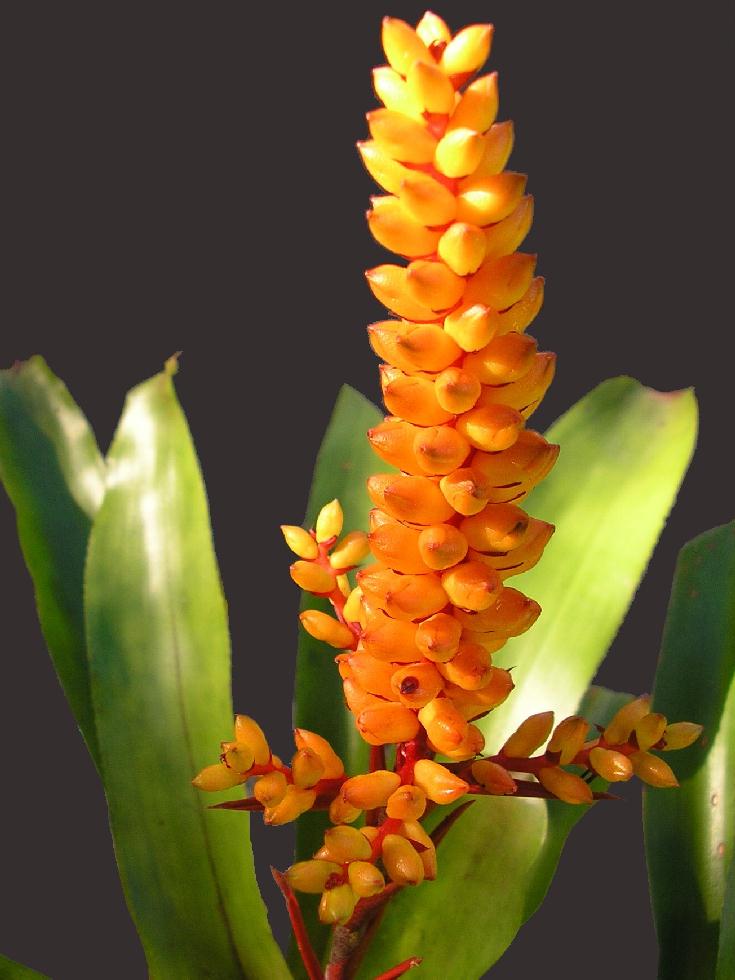
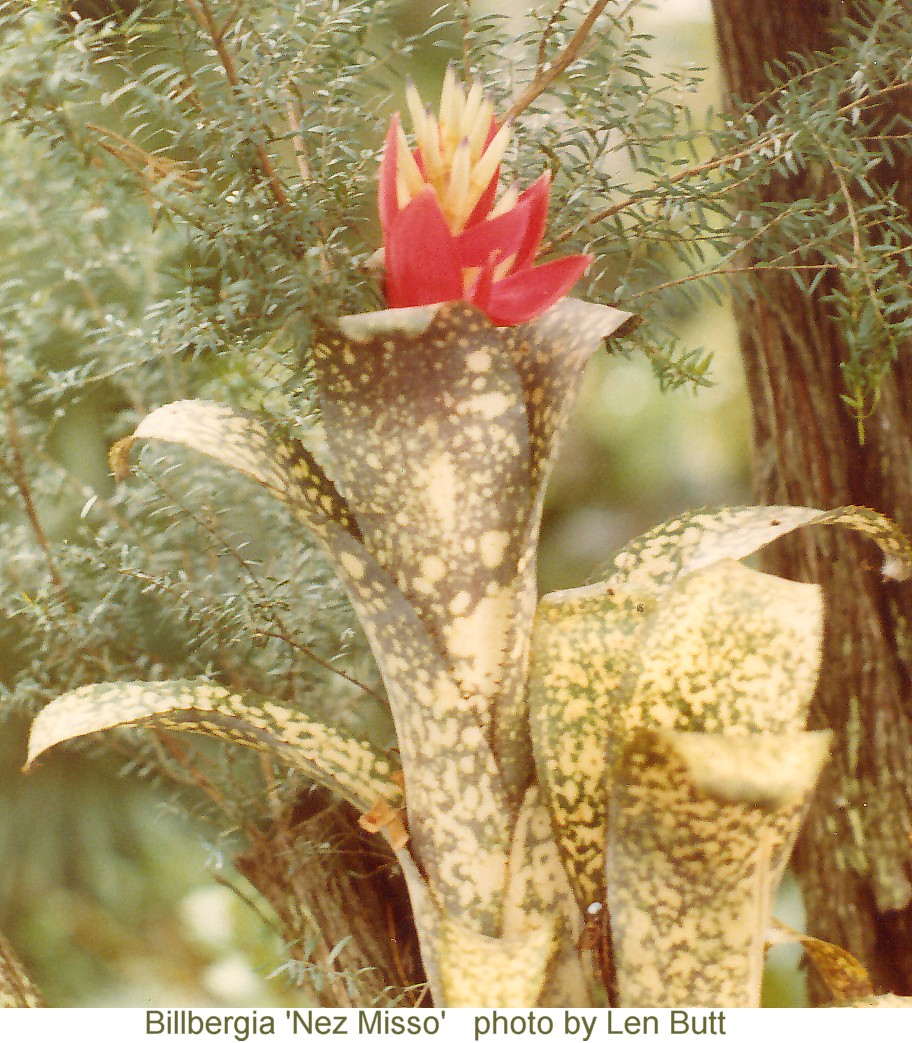

| Portea ?. Really A. callichroma | A. ‘Len Butt’ A GG hybrid | B. ‘Nez Misso’ |
Len Butt because of the various ways of growing Bromeliads au naturelle. I think, even then, he was on his anti-pin-spot scale crusade which he never really won. Luckily for South Australia this pest has not mutated and just one Adelaide winter knocks them dead. His penchant for detail when taking photographs also impressed me. He was more of a general gardener than one-eyed for Bromeliads and took a keen interest in Palms and Cycads. He was vitally involved with the gardening magazine “The Queensland Gardener” for many years.

My first real contact in Sydney was with Doreen and Peter Johnston who lived up Kuringai Chase way. Doreen was Secretary of the BSA for 10 years and also did much work behind the scenes. I well remember a trip they made which included Adelaide where she was so impressed with our keenness she sent us old copies of Bromeletter, which were read from cover to cover. I still have these on file in my den having rescued them from the library. I often wonder about the function of a newsletter, a gazette, or a Journal. When does one cease to be a chatty advice of current interests to become one worthy of retention for future reference for information. Certainly Bromeletter, despite its title is worthy of retention and information indexed. Alas, these days the standard has dropped dramatically.
In 1981 Doreen spoke at the first Bromeliad Conference in Melbourne on pests and diseases. This was also the time when Sydneysiders realised that the dreaded pinspot scale had arrived in Sydney from up North with a vengeance.
On the lighter side Grace tells me that Doreen was always keen to publicise Bromeliads and managed to get the local paper to send round a reporter. His knowledge of plants in general and Bromeliads in particular was abysmal. In desperation, Doreen said “Surely you have heard of Billbergias!” Shamed of his ignorance the reporter replied “Oh Yes. He lives a few streets away!”
Doreen was a keen advocate for learning, did no hybridising as far as I am aware, but got a Billbergia named after her. Peter, her husband joined in now and again and in this early period gave a talk to the Sydneysiders on “Golden Oldies” where he pointed out that members may know the new names but few could pick out the three varieties of Aechmea recurvata! Needless to say, this problem is still with us. Aechmea recurvata var. ortgiesii does not have a visible scape to the inflorescence!
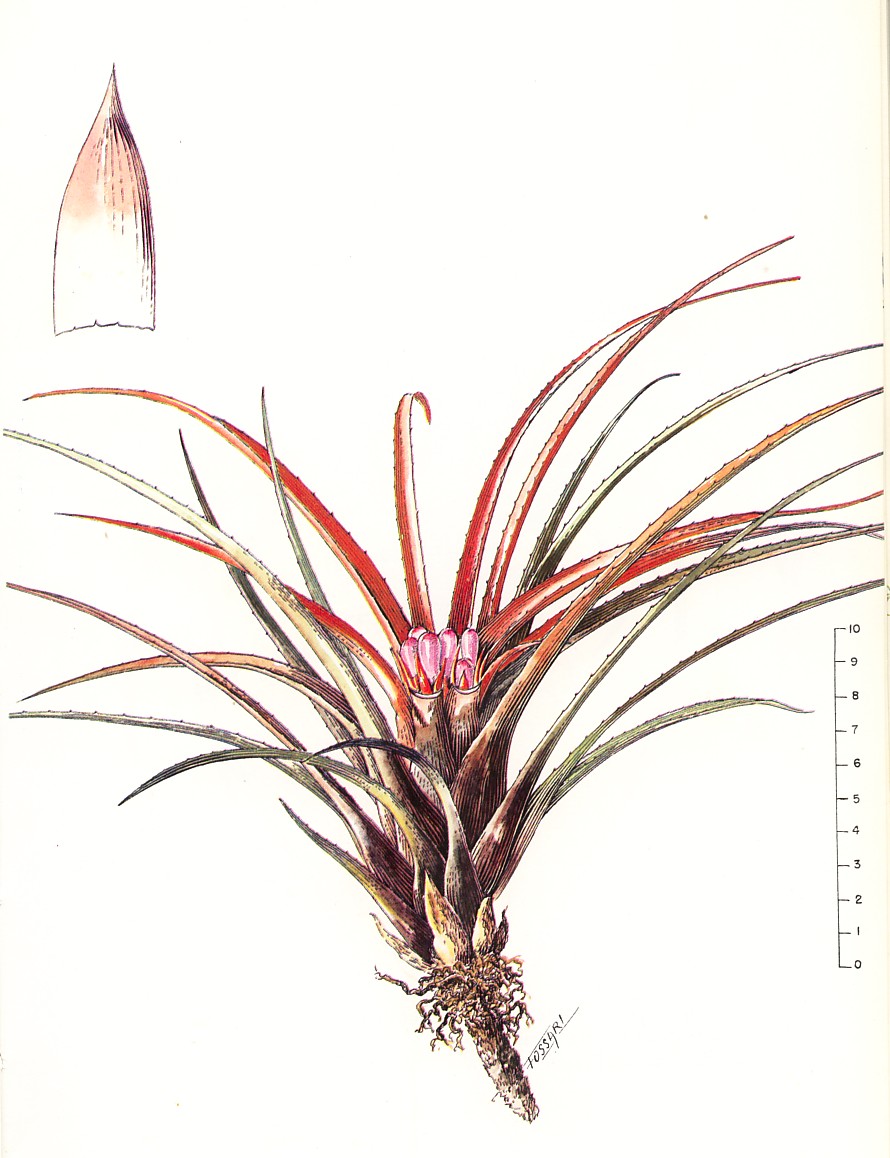

 Ae. recurvatt's.
Ae. recurvatt's.
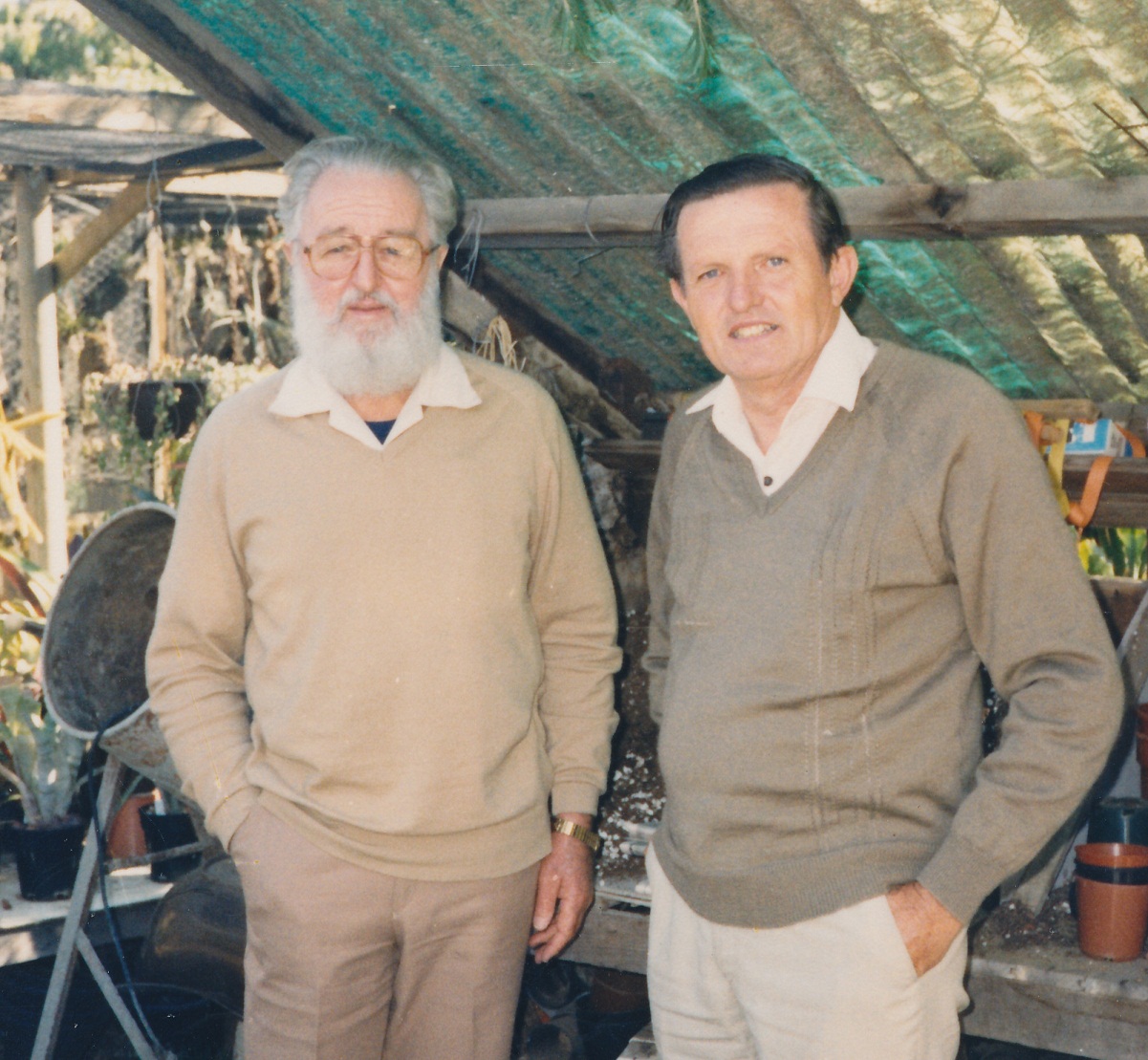
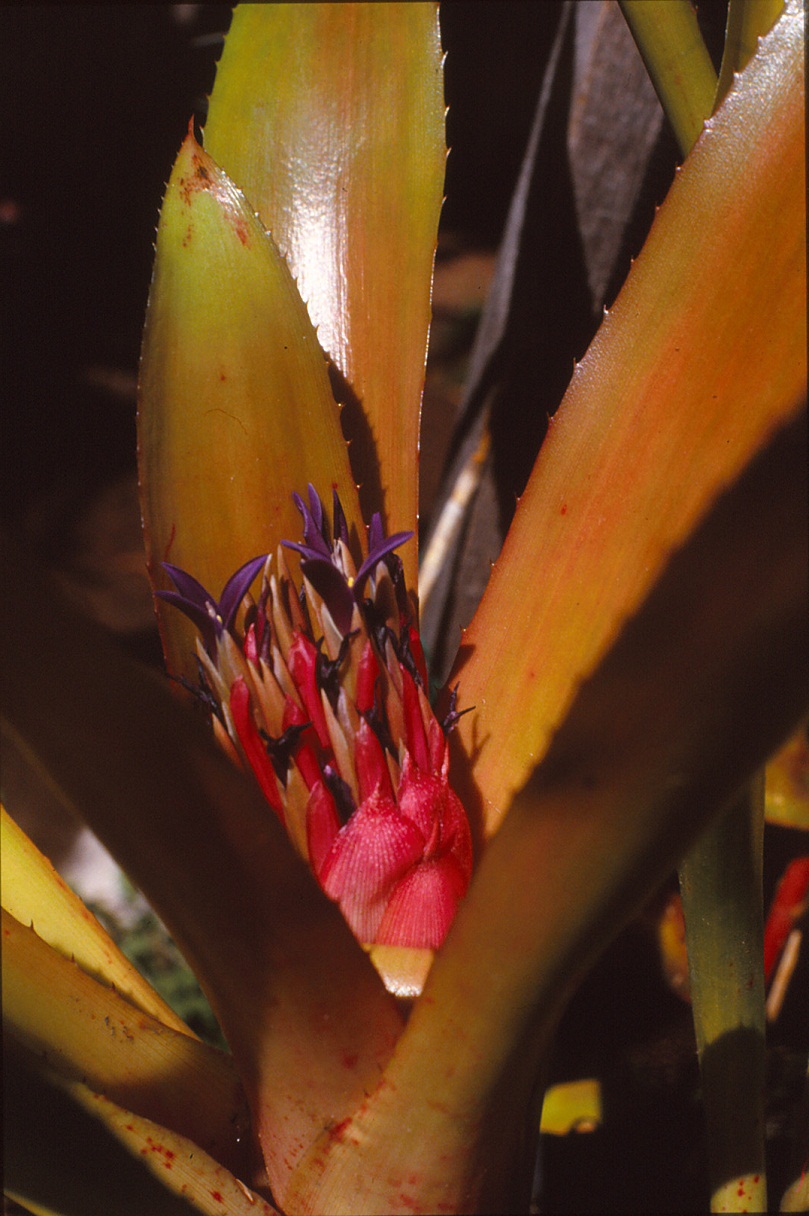
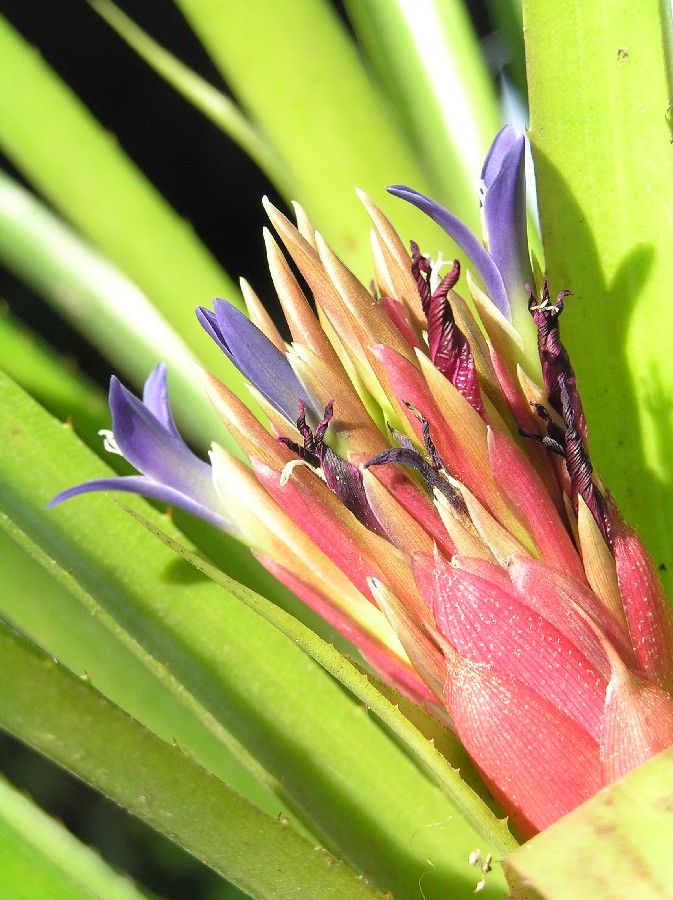
| Dick Phillips & Bill Morris | xNeobergia ‘Noddy’ N. carolinae x B. nutans |
Bill Morris from the Newcastle area has and always will be the main influence on my Bromeliad career. He taught me how to critically look at plants and not take for granted what others said or had written about. If he had a fault it was being a gardener rather than one-eyed for Bromeliads. Once he got that lack of challenge he moved into another field. Anyone who visited his place knew where his current interests were! From memory they were Haworthia, Aloe, Hoya, Geranium, Sansevieria, Epiphytic Cactus, Orchids, Begonia, Bulbs, and of course, Clivia. Bill didn’t write many articles for journals but was a prolific letter writer and had contacts around the World. He was an innocent opponent (if that is the right word) of the great Mulford Foster. Bill did hybridize in the 1960’s and succeeded with a Bigeneric now called xNeobergia ‘Noddy’ (Neoregelia carolinae x Billbergia nutans) when Mulford was failing to achieve success. Just who was this upstart from Oz! This success opened doors for Bill and Mulford became a valued contact.

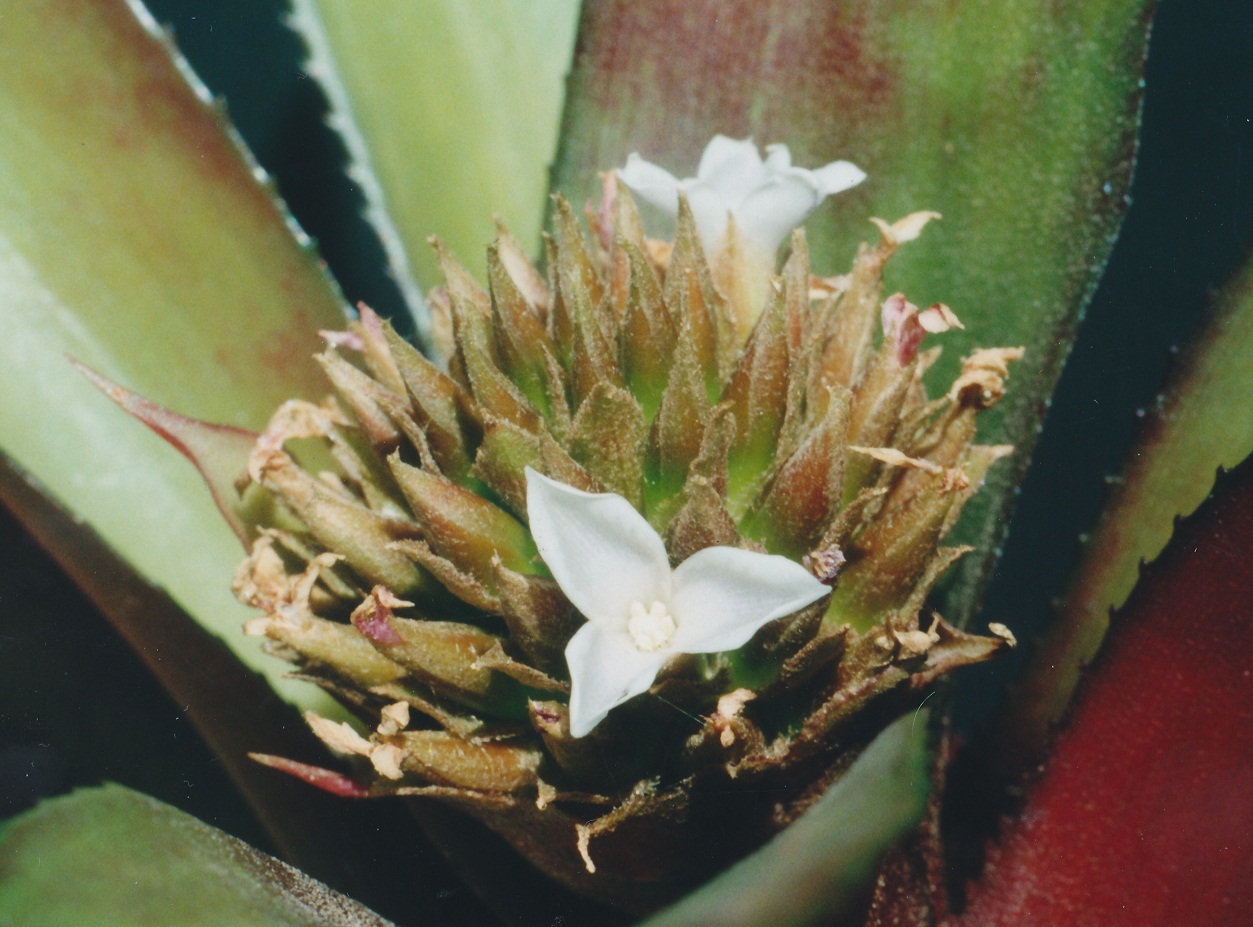
xAechopsis ‘Newk’
On the home front Bill was hybridizing but not naming his plants as he should. The Girls (I called them The Girls in those days!) Grace and Olwen gave names to Bill’s plants much to Bill’s annoyance but they got the message through to Bill. So we have Billbergia ‘Bill Morris’, ‘Bill’s Baby’, ‘Bill’s Giant’, and a Neoregelia ‘Bill’s Beauty’ which really upset him!

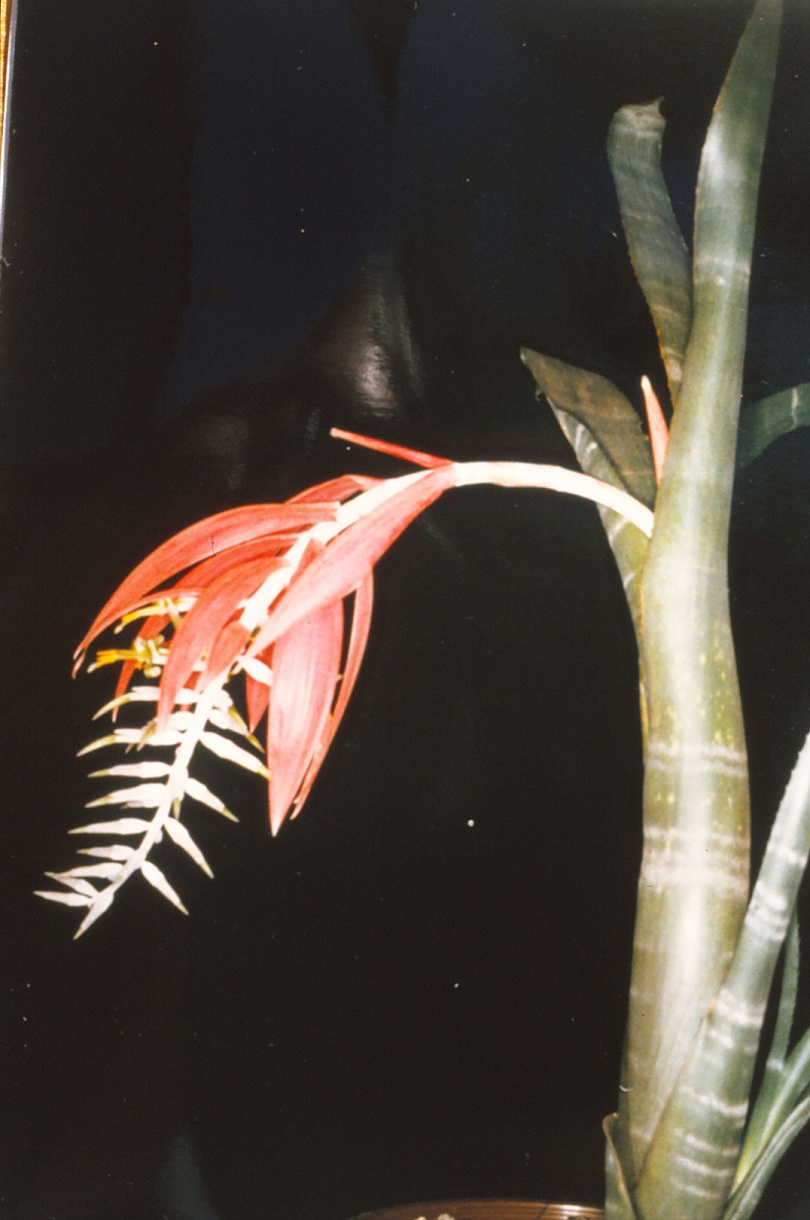
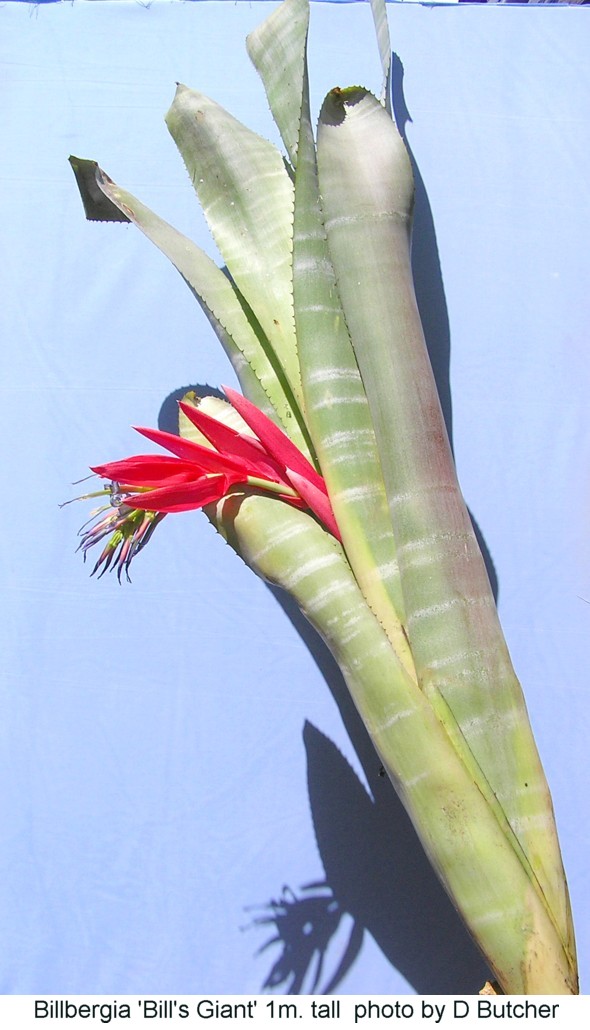
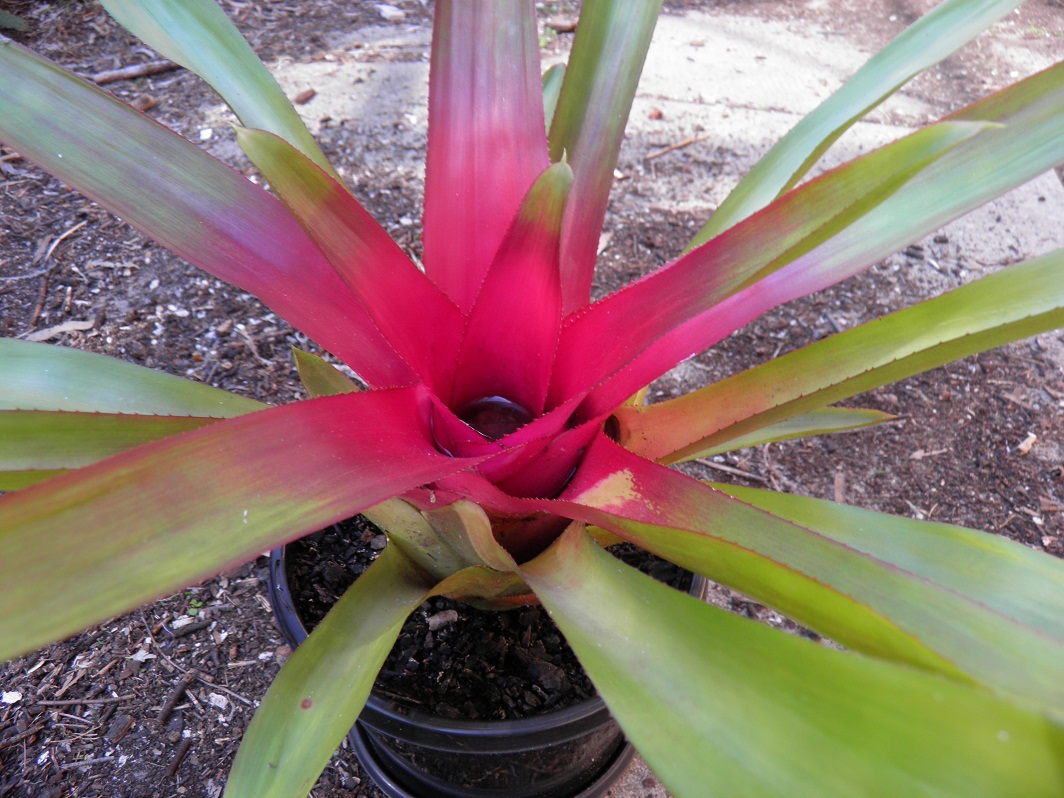
| B. ‘Bill Morris’ | B. ‘Bill’s Baby’ | B. ‘Bill’s Giant’ | N. ‘Bill’s Beauty’ |
On a more serious note, it must have been in the 1960’s that Bill Morris sent a specimen of Aechmea gigantea to Lyman Smith because you can find reference to it in 'Flora Neotropica' page 1799.
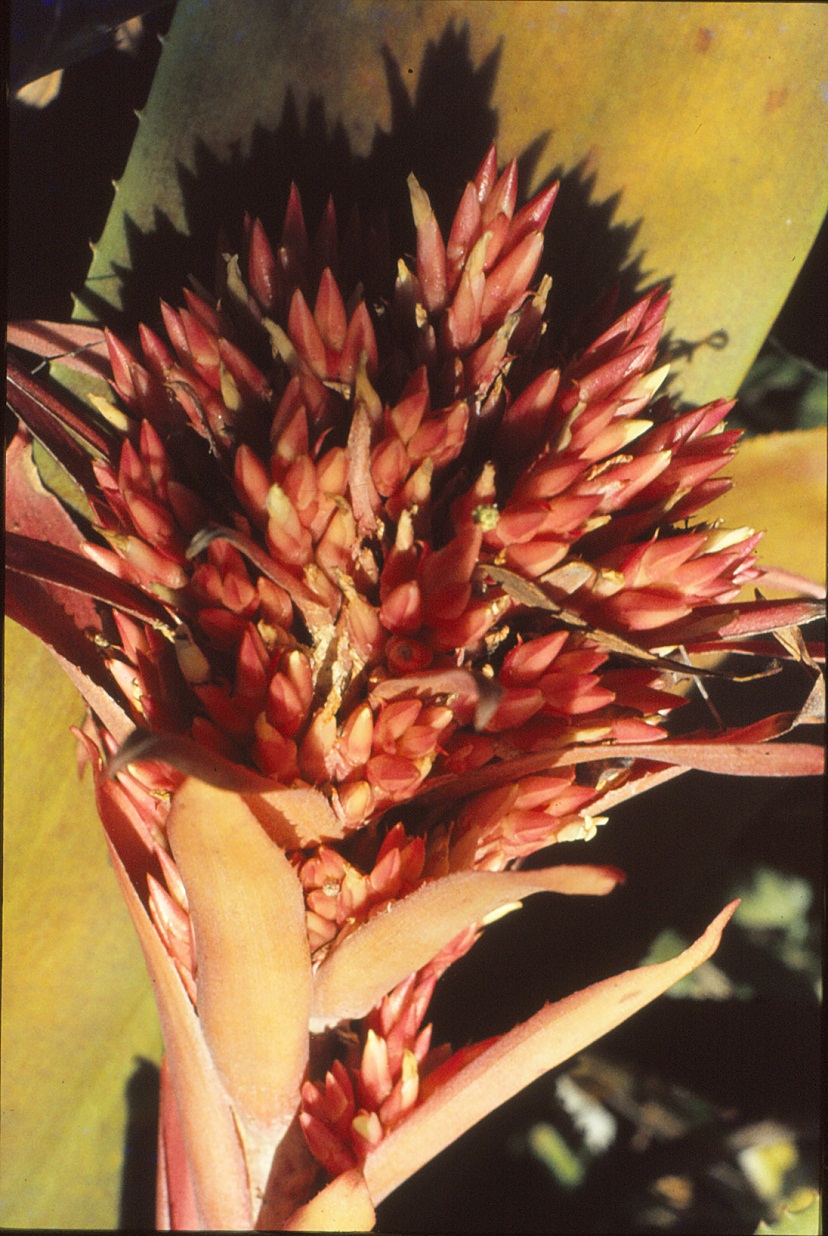
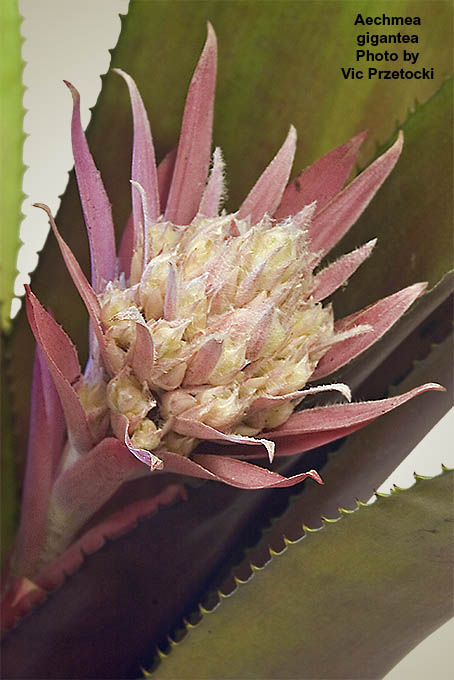
Aechmea gigantea, Photo by Vic Przetocki.
According to my gleanings this is the only Australian cited in these works. So Bill had Aechmea gigantea and knew it as such. In 1987 in Bromeletter Olwen Ferris related the story that in 1963, Bob Agnew, the then editor of Bromeletter, sent an Aechmea gigantea specimen to Lyman Smith for identification only to be advised that it was really A. sphaerocephala (flower head like a sphere or ball). This is in contradiction to what Bill was told! Anyway, Olwen said that, and I quote, “all of us changed the label to A. sphaerocephala” . Perhaps the “all” did not include Bill Morris!
Even though Olwen pointed out the error in 1987 that we were really growing A. gigantea you still come across this plant with the wrong label. Uncle Derek says “Never trust the name on the label because it is fascinating to find out the correct situation!”
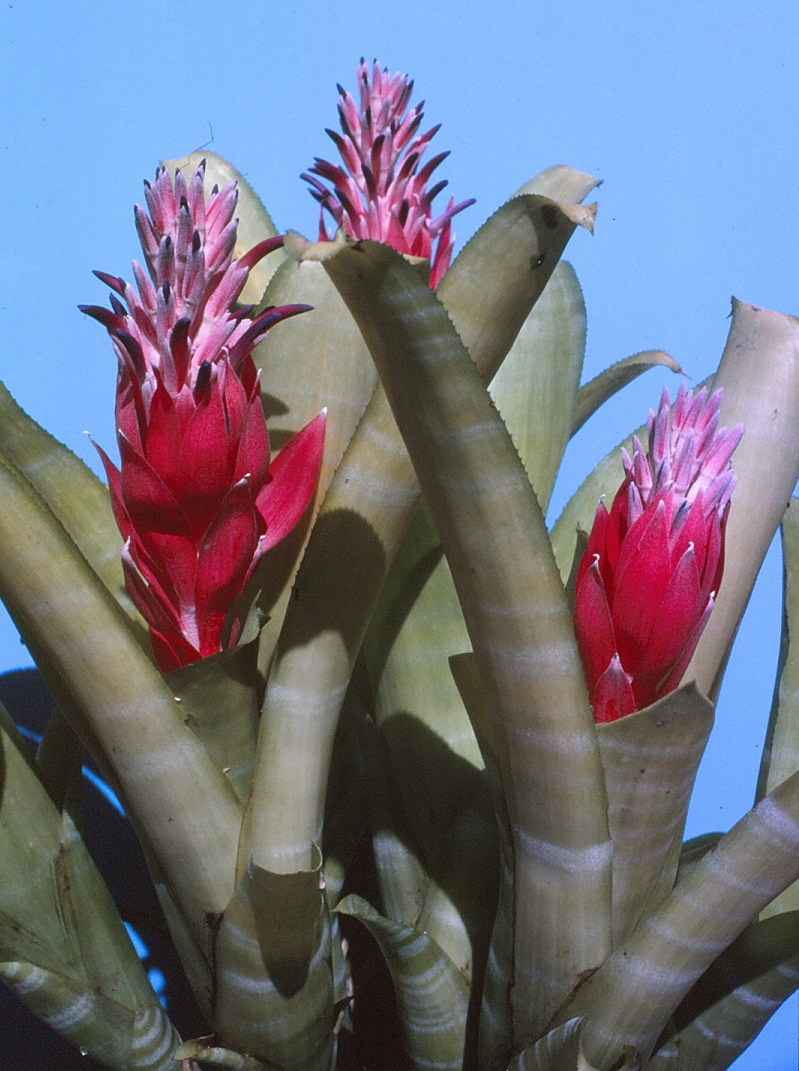
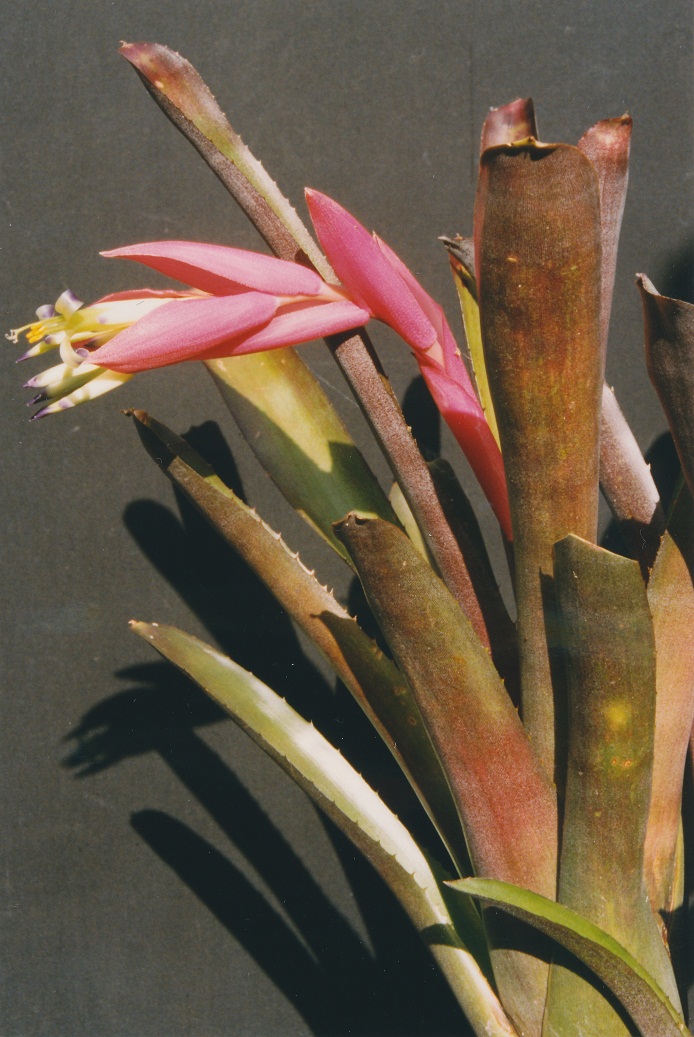
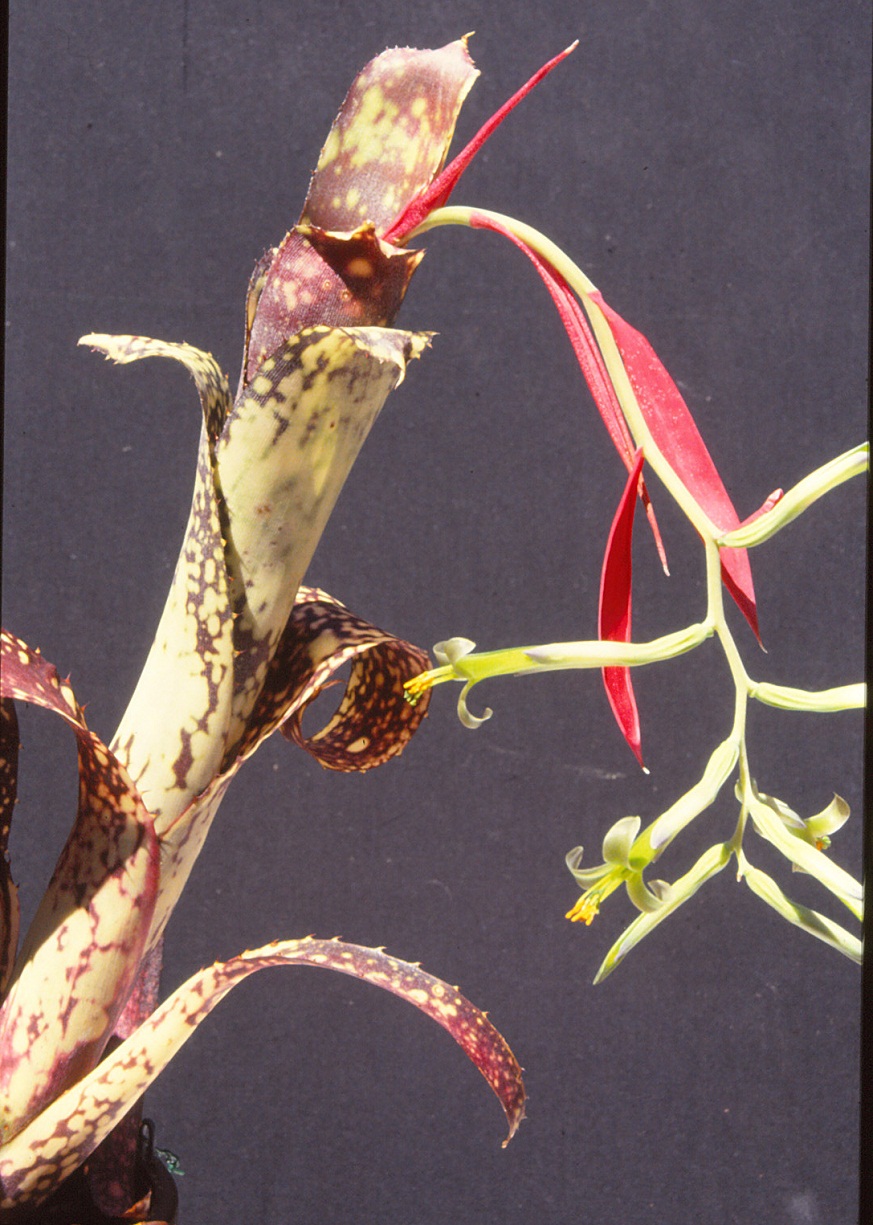
| B. ‘Gala’ | B. ‘Mulberry Pie’ | B. ‘Golden Joy’ |
 Inside Maurie’s igloo
Inside Maurie’s igloo
Finally to Victoria where the ever young Maurie Kellett resides. While he has been ever young he has always been an Accountant which I used to hold in awe. Maurie dispelled that impression when I asked him some curly question he would say “But I’m only an Accountant!”. He would always help people out of a rut and I’m not sure he was a very good salesman. I well remember him sowing thousands of Tillandsia seeds on stockings (or was it panty hose?) and then attaching the resulting seedlings to rather large square pieces of reconstituted cork with plastic coated wire. These were $5 irrespective of the size of the plant and at first the size of the plant suggested you were really paying for the cork! As years went by the plants got bigger but the price remained the same! Maurie started a trend in Australia of growing tillandsias in bulk from seed and was followed by Rolly Reilly in Queensland. Unbeknownst to either, tillandsias hybridize as easily as neoregelias but it takes 10 years longer to find out. As Bill Morris taught me “Never trust the name on the label.” and I can tell you I have come across many interesting oddities of Tillandsia species over the years from both Maurie and Rolly. BUT I can assure you I have enjoyed every minute of my investigations.
Maurie has been me best mate for at last 30 years because at the First Conference in Melbourne Maurie said, and I quote “If all commercial growers were encouraged to adopt a standard set of rules, and the buying public could familiarize itself with these rules, the seller would know exactly what he was selling, and better still, the customer would know exactly what he was buying.”
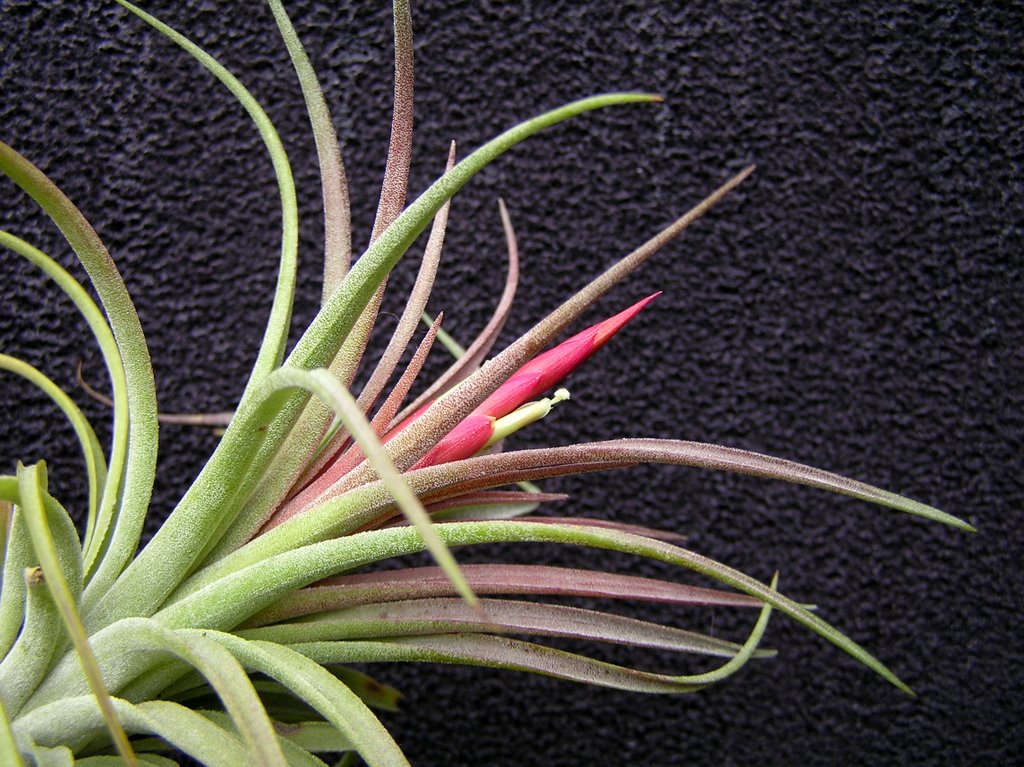
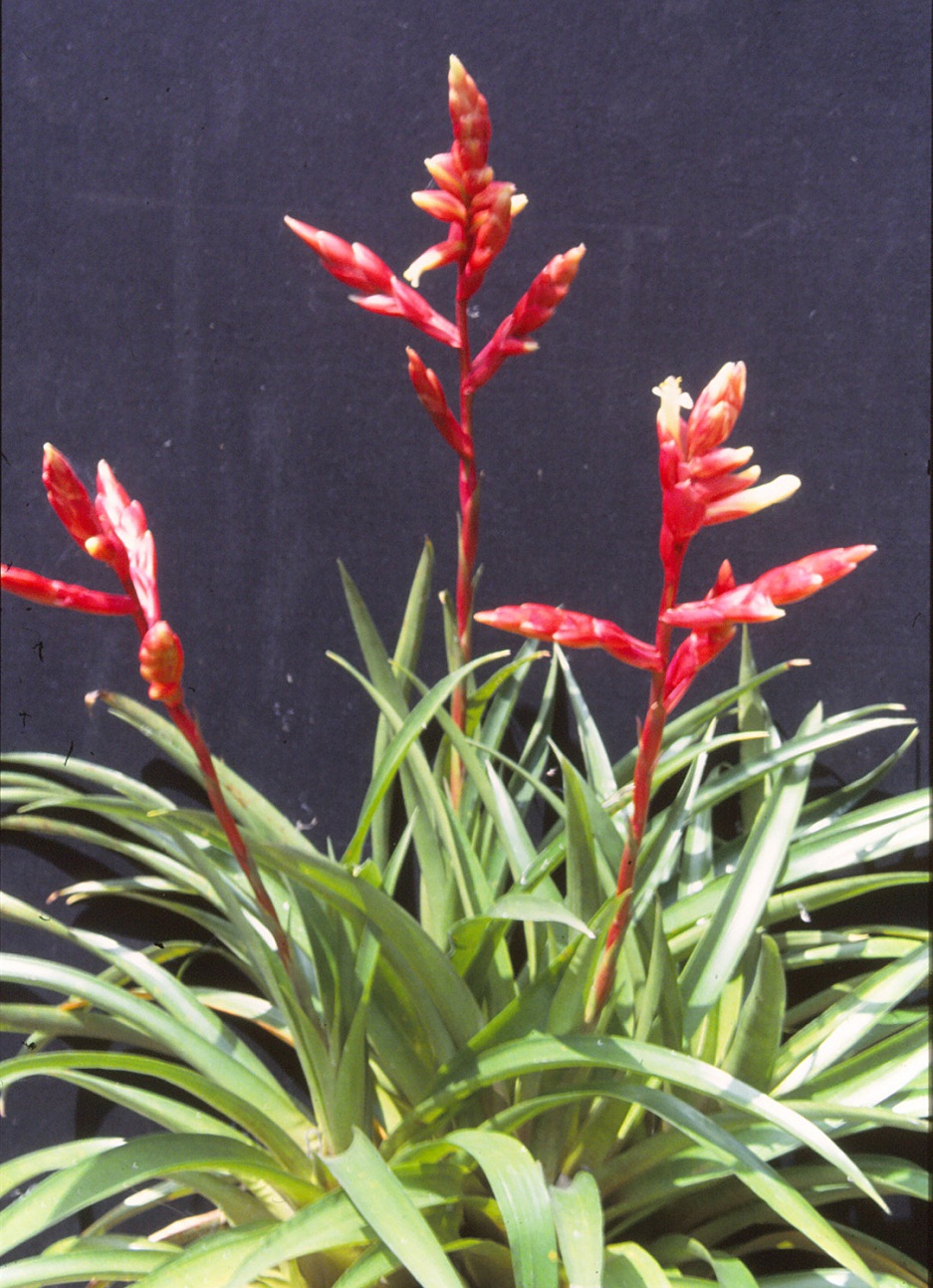

| T. ‘Flaming Maurie’ | *Vr. ‘Raemaur Flame’ | Vr. ‘Raemaur Red Satin’ |
Vr. ‘Raemaur Flame’ is interesting because it is part of the Vr. ‘Komet’ saga where Pinckert in Germany took over from Richter in promoting this form of Vriesea.
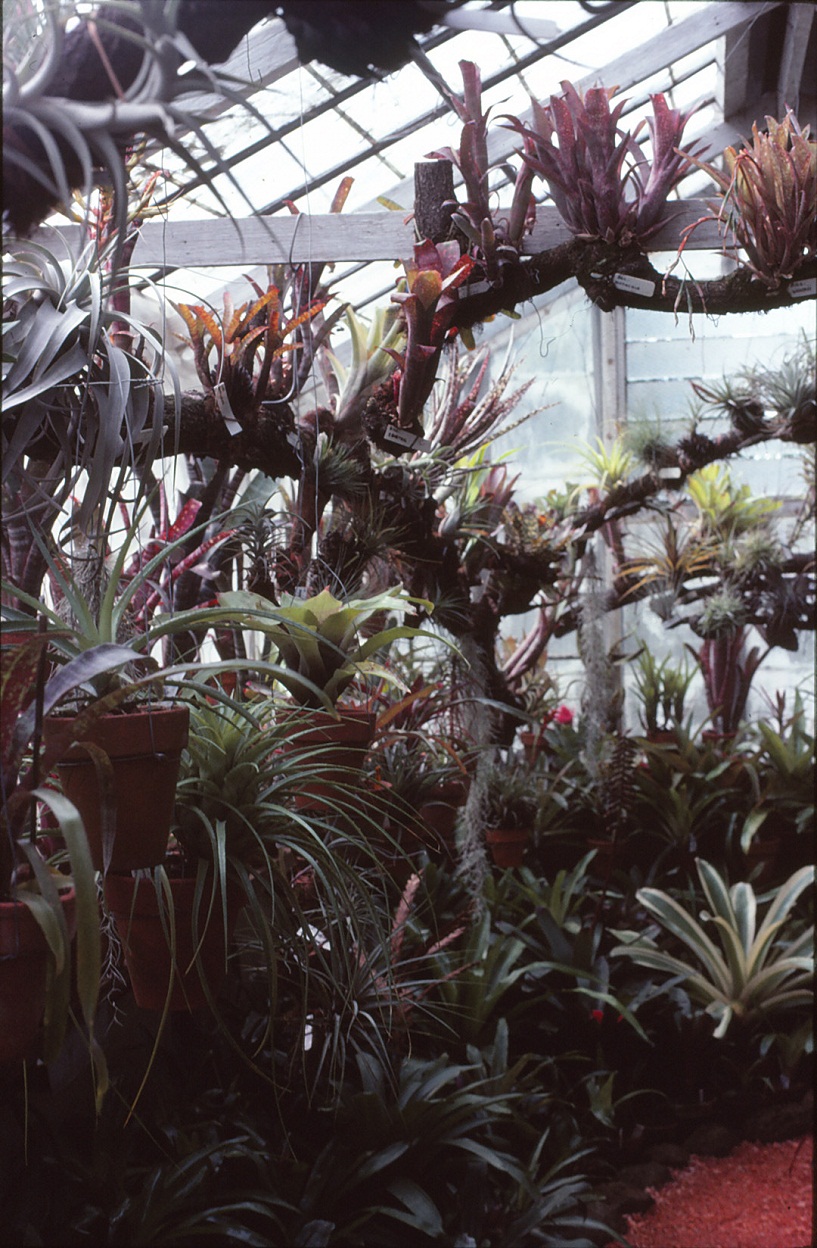
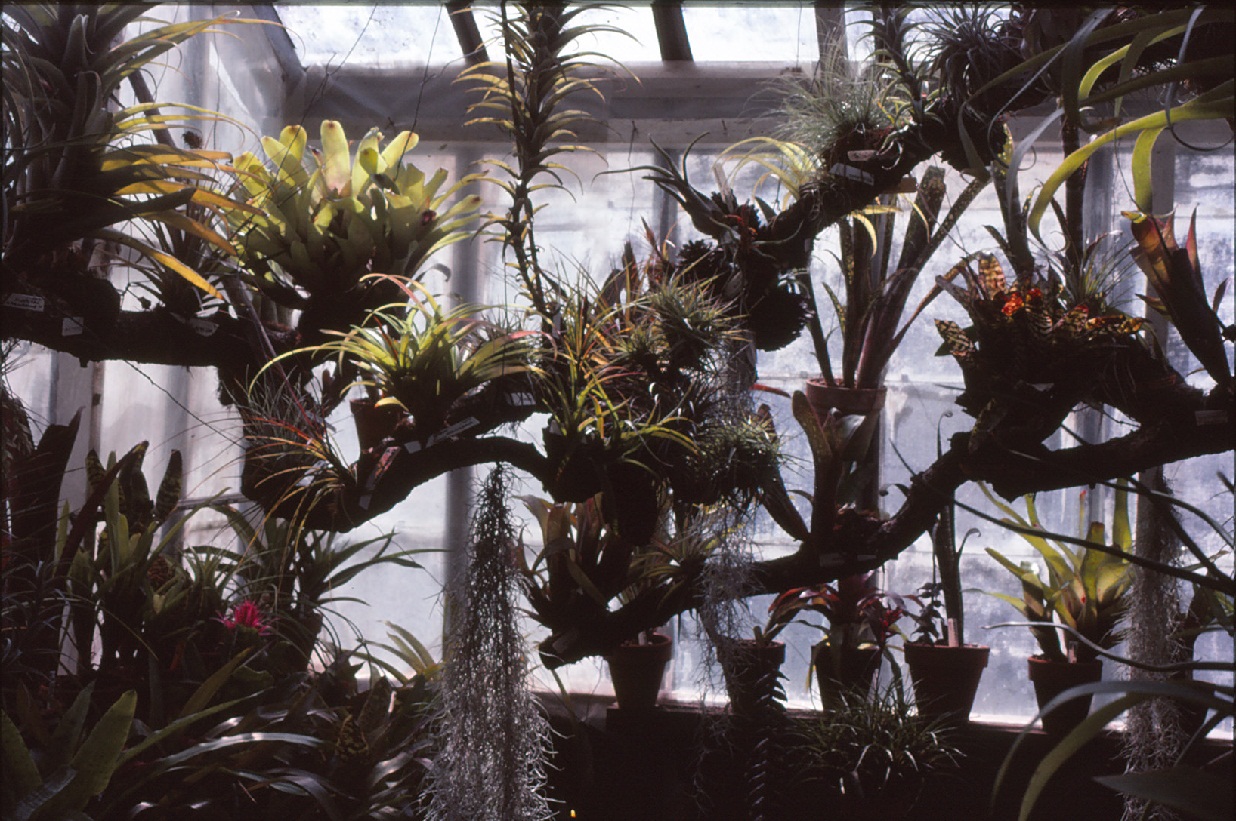
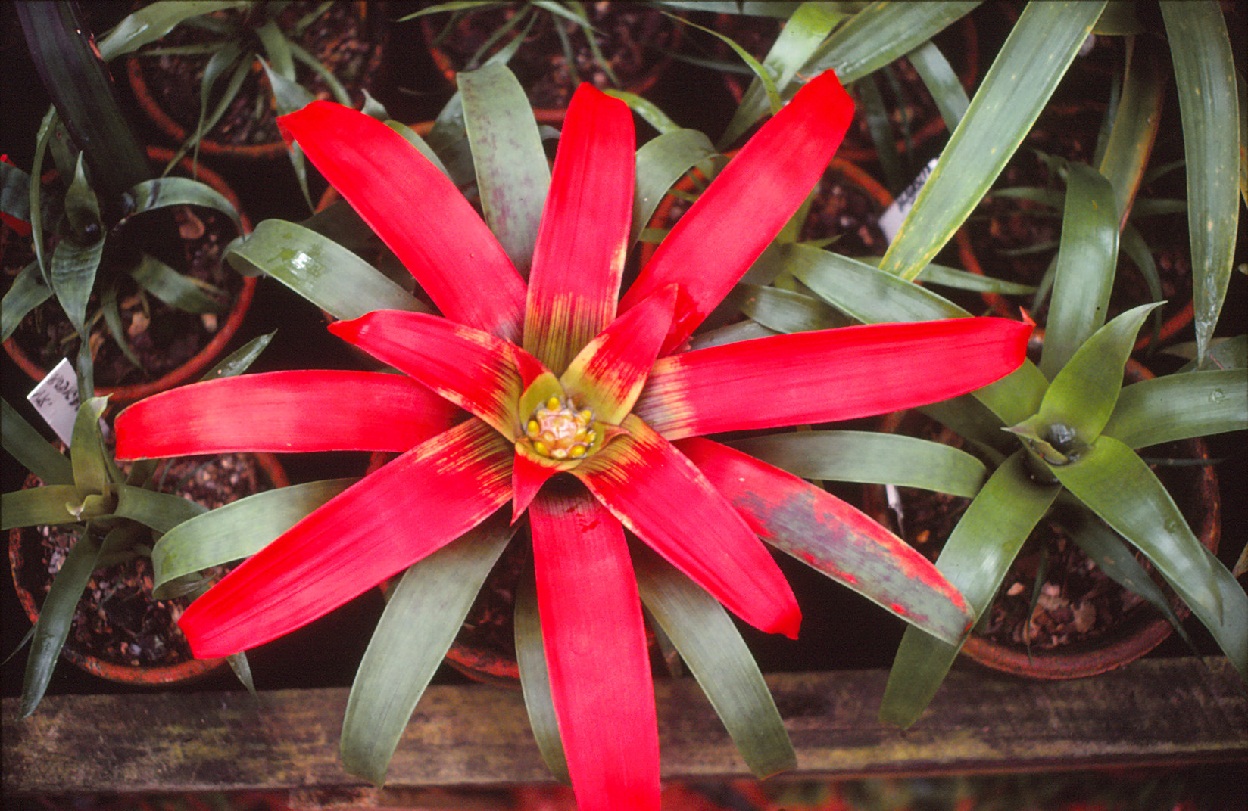
| Hal Ellis glasshouse | *Guz. sanguinea |
*Guz. sanguinea - the first we had ever seen in the flesh.
Finally, I must mention Hal Ellis who burst into the Bromeliad scene for a few brief years before he died ‘in harness’ so to speak. He was a convert from Orchid growing and as with all converts he was full of zeal. Even his Bromeliads responded to his zeal and always looked ready to jump out of their pots if he asked them to! I now know why because Grace tells me he was an ex-Army Officer! He was a great believer in learning by practice and sharing the knowledge gained with others. He was not impressed with people who just regurgitated the facts written by others. I mentioned what I considered Hal’s ‘Pearls of Wisdom’ in an article in Bromeletter and he, not I, got some brickbats. Regrettably you still see it to this day where some Editors seem forced to use reprints from other newsletters and no attempt is made to amend cultural recommendations to the conditions prevailing in that local area or update nomenclature. If only Editors could get people to write about their experiences. There is a wealth of knowledge out there and it needs to be shared via the written word. Discussion is healthy provided it is on a level playing field.
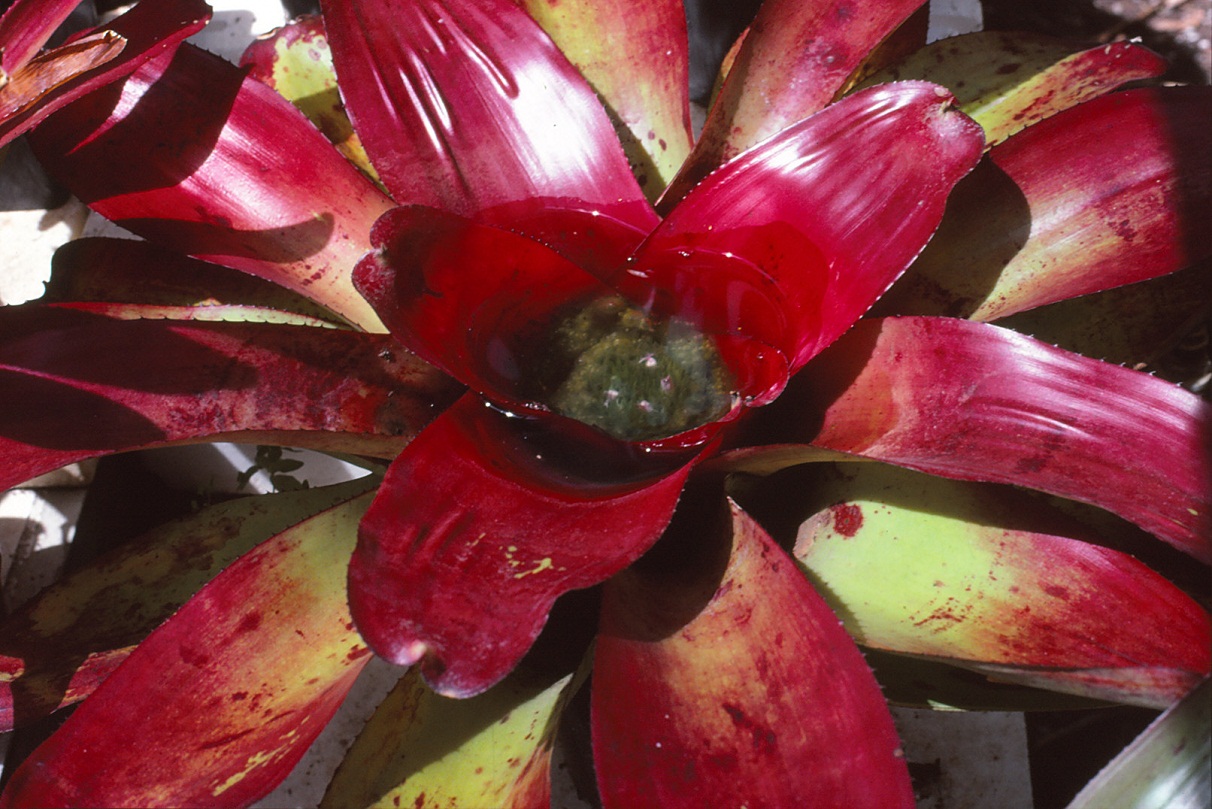 N. ‘Hal Ellis’. Photo Len Colgan.
N. ‘Hal Ellis’. Photo Len Colgan.
Finally, just one of Hal’s “Pearls of wisdom” from his farming days. If you have a good plant that you want to produce good offsets treat it with the same care and attention a farmer does for a high milk-yielding cow of whatever age!
We have just had yet another successful Brom Conference in Darwin but somehow they are not quite like the golden days!
It has been reported that at one Conference three of our most prestigious growers were seen with arms linked, dancing down the corridor singing “Three little girls from School, are we” They were outside the door of an equally prestigious temperate male. Luckily he did not waken and neither did he see the stack of empty bottles piled by the door because they were removed by hotel staff who thought they were his breakfast cleanup!
Updated 06/04/15







































 Ae. recurvatt's.
Ae. recurvatt's.












 Inside Maurie’s igloo
Inside Maurie’s igloo





 N. ‘Hal Ellis’. Photo Len Colgan.
N. ‘Hal Ellis’. Photo Len Colgan.